Microsoft RM-41 Tri Mode Dual Band PCS Phone User Manual Austin 3155i 21Dec05
Microsoft Mobile Oy Tri Mode Dual Band PCS Phone Austin 3155i 21Dec05
Contents
- 1. Manual generic
- 2. Manual
- 3. Users guide
Users guide
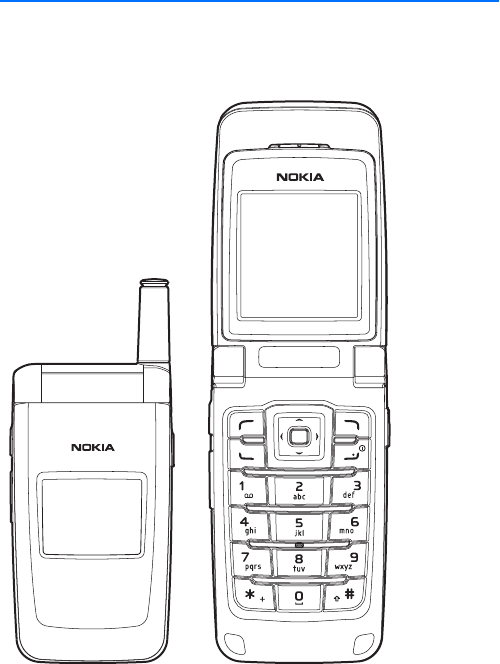
1
Nokia 3155i User Guide

2
LEGAL INFORMATION
DECLARATION OF CONFORMITY
We, NOKIA CORPORATION declare under our sole responsibility that the products Nokia
3155i are in conformity with the provisions of the following Council Directive: 1999/5/EC. A
copy of the Declaration of Conformity can be found at http://www.nokia.com/phones/
declaration_of_conformity/.
PART NO. 9241731, ISSUE NO. 1
Copyright ©2005 Nokia. All rights reserved.
Nokia, Nokia Connecting People, Nokia 3155i, Pop-Port™, and the Nokia Original
Enhancements logos are trademarks or registered trademarks of Nokia Corporation. Other
company and product names mentioned herein may be trademarks or trade names of their
respective owners.
US Patent No. 5818437 and other pending patents. T9 text input software
Copyright ©1999-2005. Tegic Communications, Inc. All rights reserved. This device may
contain commodities, technology, or software subject to export laws and regulations from
the US and other countries. Diversion contrary to law is prohibited.
Includes RSA BSAFE cryptographic or security protocol software from RSA
Security.
Java™ is a trademark of Sun Microsystems, Inc.
The information contained in this user guide was written for the Nokia 3155i product. Nokia
operates a policy of ongoing development. Nokia reserves the right to make changes to any
of the products described in this document without prior notice.
UNDER NO CIRCUMSTANCES SHALL NOKIA BE RESPONSIBLE FOR ANY LOSS OF DATA OR
INCOME OR ANY SPECIAL, INCIDENTAL, AND CONSEQUENTIAL OR INDIRECT DAMAGES
HOWSOEVER CAUSED. THE CONTENTS OF THIS DOCUMENT ARE PROVIDED “AS IS.” EXCEPT
AS REQUIRED BY APPLICABLE LAW, NO WARRANTIES OF ANY KIND, EITHER EXPRESS OR
IMPLIED, INCLUDING, BUT NOT LIMITED TO, THE IMPLIED WARRANTIES OF
MERCHANTABILITY AND FITNESS FOR A PARTICULAR PURPOSE, ARE MADE IN RELATION TO
THE ACCURACY AND RELIABILITY OR CONTENTS OF THIS DOCUMENT. NOKIA RESERVES THE
RIGHT TO REVISE THIS DOCUMENT OR WITHDRAW IT AT ANYTIME WITHOUT PRIOR NOTICE.
EXPORT CONTROLS This device may contain commodities, technology, or software subject to
export laws and regulations from the U.S. and other countries. Diversion contrary to law is
prohibited.
3
FCC/INDUSTRY CANADA NOTICE
Your device may cause TV or radio interference (for example, when using a telephone in close
proximity to receiving equipment). The FCC or Industry Canada can require you to stop using
your telephone if such interference cannot be eliminated. If you require assistance, contact
your local service facility. This device complies with part 15 of the FCC rules. Operation is
subject to the condition that this device does not cause harmful interference. Any changes or
modifications not expressly approved by Nokia could void the user’s authority to operate this
equipment.

Contents
4
Contents
For your safety 5
1. Phone at a glance......................................................................................................... 10
2. Set up your phone ........................................................................................................ 15
3. Text entry........................................................................................................................ 23
4. My account .................................................................................................................... 26
5. Call history ..................................................................................................................... 27
6. Messages ........................................................................................................................ 29
7. Contacts.......................................................................................................................... 38
8. My stuff .......................................................................................................................... 45
9. Tunes................................................................................................................................ 47
10. Settings........................................................................................................................... 51
11. Tools................................................................................................................................. 69
12. VXL ................................................................................................................................... 79
13. PC connectivity ............................................................................................................. 81
14. Enhancements............................................................................................................... 84
15. Care and maintenance................................................................................................ 88
16. Additional safety information................................................................................... 89
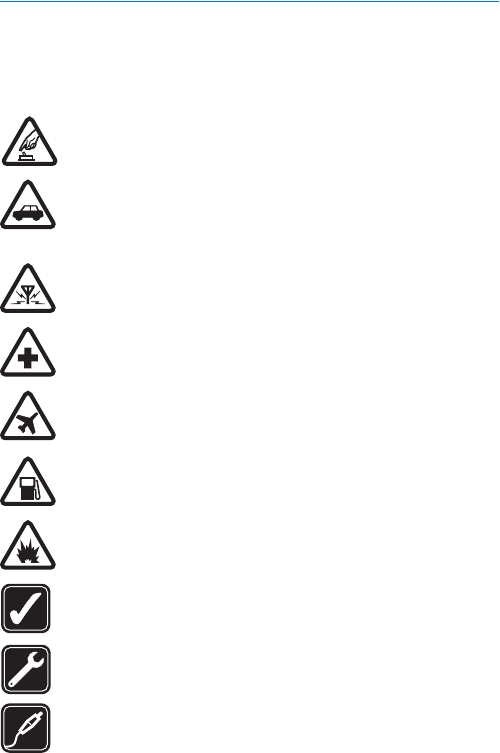
For your safety
5
For your safety
Read these simple guidelines. Not following them may be dangerous or illegal.
Read the complete user guide for further information.
SWITCH ON SAFELY
Do not switch the phone on when wireless phone use is prohibited or
when it may cause interference or danger.
ROAD SAFETY COMES FIRST
Obey all local laws. Always keep your hands free to operate the
vehicle while driving. Your first consideration while driving should be
road safety.
INTERFERENCE
All wireless phones may be susceptible to interference, which could
affect performance.
SWITCH OFF IN HOSPITALS
Follow any restrictions. Switch the phone off near medical
equipment.
SWITCH OFF IN AIRCRAFT
Follow any restrictions. Wireless devices can cause interference in
aircraft.
SWITCH OFF WHEN REFUELING
Do not use the phone at a refueling point. Do not use near fuel or
chemicals.
SWITCH OFF NEAR BLASTING
Follow any restrictions. Do not use the phone where blasting is in
progress.
USE SENSIBLY
Use only in the normal position as explained in the product
documentation. Do not touch the antenna unnecessarily.
QUALIFIED SERVICE
Only qualified personnel may install or repair this product.
ENHANCEMENTS AND BATTERIES
Use only approved enhancements and batteries. Do not connect
incompatible products.

For your safety
6
WATER-RESISTANCE
Your phone is not water-resistant. Keep it dry.
BACK-UP COPIES
Remember to make back-up copies or keep a written record of all
important information stored in your phone.
CONNECTING TO OTHER DEVICES
When connecting to any other device, read its user guide for detailed
safety instructions. Do not connect incompatible products.
EMERGENCY CALLS
Ensure the device is switched on and in service. Press the end key as
many times as needed to clear the display and return to the start
screen. Enter the emergency number, then press the call key. Give
your location. Do not end the call until given permission to do so.
■About your device
The wireless device described in this guide is approved for use on the CDMA 800
and 1900, AMPS, and GPS networks. Contact Virgin Mobile for more information
about networks.
When using the features in this device, obey all laws and respect privacy and the
legitimate rights of others.
Warning: To use any features in this device, other than the alarm clock,
the device must be switched on. Do not switch the device on when
wireless phone use may cause interference or danger.
■Network services
To use the phone you must have service from Virgin Mobile. Many of the features
in this device depend on features in the wireless network to function. These
network services may not be available on all networks or you may have to make
specific arrangements with Virgin Mobile before you can utilize network services.
Virgin Mobile may need to give you additional instructions for their use and
explain what charges will apply. Some networks may have limitations that affect
how you can use network services. For instance, some networks may not support
all language-dependent characters and services.
Virgin Mobile may have requested that certain features be disabled or not
activated in your device. If so, they will not appear on your device menu. Your
device may also have been specially configured. This configuration may include
For your safety
7
changes in menu names, menu order, and icons. Contact your service provider for
more information.
This device supports WAP 1.1 protocols (HTTP and SSL) that run on TCP/IP
protocols. Some feature of this device, such as VXL, require network support for
these technologies.
■Shared memory
This device has 12 MB of internal memory. The following features in this device
may share memory: contacts; text messages; photos, images, and tones in My
Stuff; calendar notes; games; and applications. Use of one or more of these
features may reduce the memory available for the remaining features sharing
memory. Your device may display a message that the memory is full when you try
to use a shared memory feature. In this case, delete some of the information or
entries stored in the shared memory features before continuing. Some of the
features, such as photos, images, and tones in My Stuff; text messages; and
applications may have a certain amount of memory specially allotted to them in
addition to the memory shared with other features.
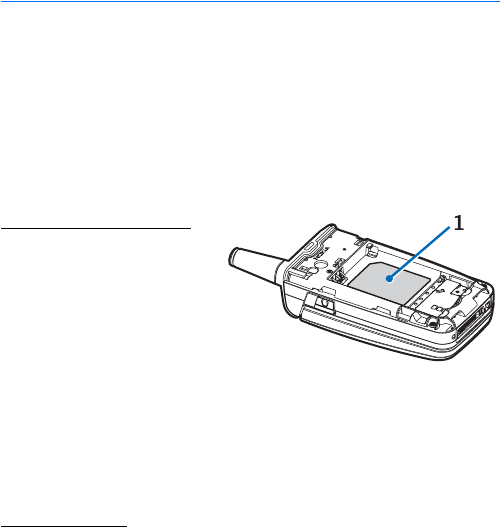
Welcome
8
Welcome
Congratulations on your purchase of the Nokia 3155i mobile phone. Your phone
provides many practical functions for daily use, such as a hands-free
loudspeaker, alarm clock, calculator, calendar, and more. Your phone can also
connect to a PC, laptop, or other device using a data cable. To personalize your
phone, you can set your favorite ring tones.
■Getting help
Find your phone label
If you need help, Nokia Customer
Care is available for assistance.
Before calling, we recommend
that you write down the following
information and have it available:
• Electronic serial number (ESN)
• Your postal code (only in the
U.S.)
The ESN is found on the type label, which is located beneath the battery on the
back of the phone. See "Remove the back cover," p. 16 and "Remove the battery,"
p. 16.
Contact Nokia
Please have your product with you when contacting any of these numbers:
Customer Care Contact Center, Canada
Nokia Products Ltd.
601 Westney Road South
Ajax, Ontario L1S 4N7
Tel: 1-888-22-NOKIA (1-888-226-6542)
Fax: 1-905-619-4360
In USA call 1-888-Nokia2U (1-888-665-4228)

Welcome
9
Updates
From time to time, Nokia updates this guide to reflect changes. The latest version
of this guide and an interactive tutorial for this product may be available at
www.nokia.ca.
Check www.nokia.ca for additional information, downloads, and services related
to the use of Nokia products and services.
Accessibility solutions
Nokia is committed to making mobile phones easy to use for all individuals,
including those with disabilities. For more information visit
www.nokiaaccessibility.com.
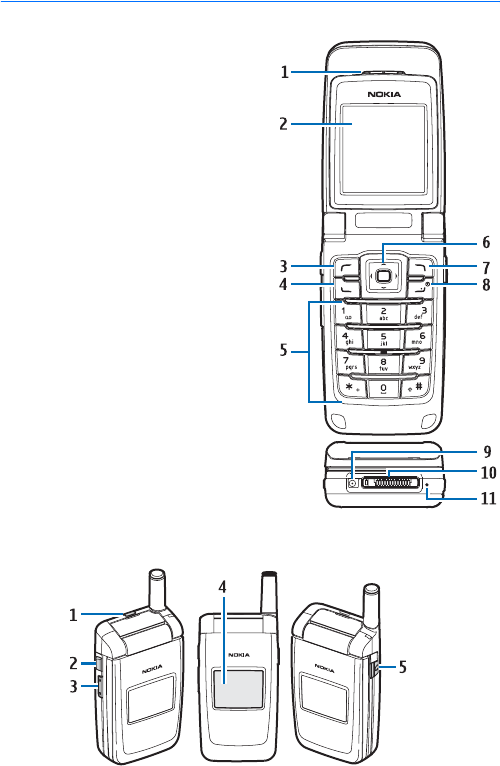
Phone at a glance
10
1. Phone at a glance
• Earpiece port (1)
• Display screen (2)
• Left selection key (3)
• Call key (4)
• Keypad (5)
• Four-way scroll and selection key (6)
• Right selection key (7)
• Power key/end key (8)
• Charger port (9)
• Pop-Port™ connector (10)
• Microphone (11)
■Keys and parts
• Loudspeaker (1)
• Voice key (2)
• Volume key (3)
• Front display (4)
• Headset jack (5)

Phone at a glance
11
You can use the voice key to answer an incoming call.
■Standby mode
Depending on your wireless service provider and the model number of your
phone, some or all of the following selection keys may appear in the standby
mode.
The standby mode is home base and indicates your phone is in the idle state.
Signal strength (1)—A higher bar indicates a stronger network signal.
Menu (2)—Press the center selection key to select this option.
Go to (3)—Press the left selection key to select this option.
VXL (4)—Press the right selection key to select this option.
Battery level (5)—A higher bar indicates more power in the battery.
■Softkeys
Note: Depending on your wireless service provider and the model
number of your phone, some or all of the following softkeys may appear
in the standby mode.
In the standby mode, the four-way scroll key instantly takes you to the following
frequently accessed menus:
Scroll left key—Text message
Scroll right key—Tunes
Scroll up key—My Account
Scroll down key—Contacts
Center selection key—Main menu or a selected submenu
■Indicators and icons
Depending on your wireless service provider and the model number of your
phone, some or all of the following indicators and icons may appear in the
standby mode.
You have new text message. See "Text messages," p. 29.
You have new voice messages. See "Voice messages," p. 35.
Your phone keypad is locked. See "Keyguard," p. 21.
Your phone is set to the silent profile. See "Profiles," p. 51.
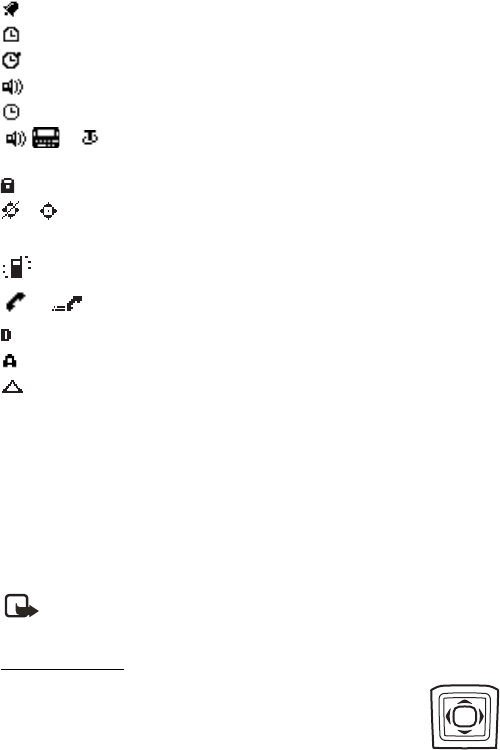
Phone at a glance
12
The alarm clock is set to on. See "Alarm clock," p. 69.
The countdown timer is running.
The stopwatch timer is running in the background. See "Stopwatch," p. 76.
Integrated hands-free is active. See "The loudspeaker," p. 20.
The timed profile is selected. See "Profiles," p. 51.
or An enhancement is connected to the phone. See
"Enhancements," p. 84.
Voice privacy encryption is active (or is not active) in the network.
or Location info sharing is set to emergency or on. See "Location info
sharing," p. 54.
Vibrating alert is active. See "Profiles," p. 51.
or Off hook, call or data call in progress.
You are in a digital network. See "Network services," p. 6.
You are in an analog network. See "Network services," p. 6.
You are roaming outside your home network. See "Roaming options," p. 66.
■Phone menus
Phone features are grouped according to function and are accessed through the
main menus. Each main menu contains submenus and lists from which you can
select or view items and customize your phone features. To access these menus
and submenus, use the scroll method or a shortcut.
You can change your menu view from list to grid. Select Menu > Options > Main
menu view > List or Grid.
Note: Some features may not be available, depending on your network.
For more information, contact your wireless service provider.
Scroll method
You can use the four-way scroll key to scroll up, down, left, and
right through the options.
1. In the standby mode, select Menu, and scroll through the main
menus using the scroll key.

Phone at a glance
13
As you scroll through the menus, the menu number appears in the upper right
corner of the display. Below the battery level indicator is a scroll bar with a
tab that moves up or down on the right side of the display screen as you scroll
through the menus, providing a visual representation of your current position
in the menu structure.
2. When you arrive at a menu, press the center selection key to select submenus.
• Select Back (the right selection key) to return to the previous menu.
• Press the end key to return to the standby mode from any menu or
submenu.
In-phone help
Many features have brief descriptions (help text) you can view on the display. To
view these descriptions, you must first activate help text as follows.
In the standby mode, select Menu > Settings > Phone > Help text activation > On
or Off.
Scroll to a feature and wait about 14 seconds. Scroll down to view all of the
description, or select Back to exit.
■Security feature
The security feature protects your device from unauthorized outgoing calls or
access to the stored information with the lock and security codes. The lock code
is a four digit number while the security code is five digits. By default, the
security feature uses the lock code to protect your phone (defaulted to the last
four digits of your phone number) instead of the security code.
You need to enter the lock code to access the following Security option:
1. In the standby mode, select Menu > Settings > Security.
2. Enter the lock code, and select OK. See "Security," p. 64.
Note: The preset lock code is set to the last four digits of your phone.
number. If it does not work, contact your wireless service provider for
help.
Your device, by default, requires you to enter the lock code to restore factory
settings:
1. In the standby mode, select Menu > Settings > Restore settings.
2. Enter the lock code, and select OK. See "Change lock code," p. 65.

Phone at a glance
14
■Go to functions
The Go to menu enables you to change the function of the left selection key on
your phone. With this function, you can quickly access your most frequently used
functions from the Go to menu in the standby mode.
Choose go to functions
1. In the standby mode, select Go to > Options > Select options.
2. Scroll up or down to highlight the desired function.
3. Select Mark to add a function or Unmark to remove a function.
4. Select Done when you have added all desired functions.
5. Select Yes to save the changes.
6. In the standby mode, select Go to to display a list of the functions you
selected in step 2.
Organize functions
1. In the standby mode, select Go to > Options > Organize.
2. Scroll up or down to highlight the function you want to rearrange, and select
Move > Move up, Move down, Move to top, or Move to bottom.
3. Select Done > Yes to save the changes.
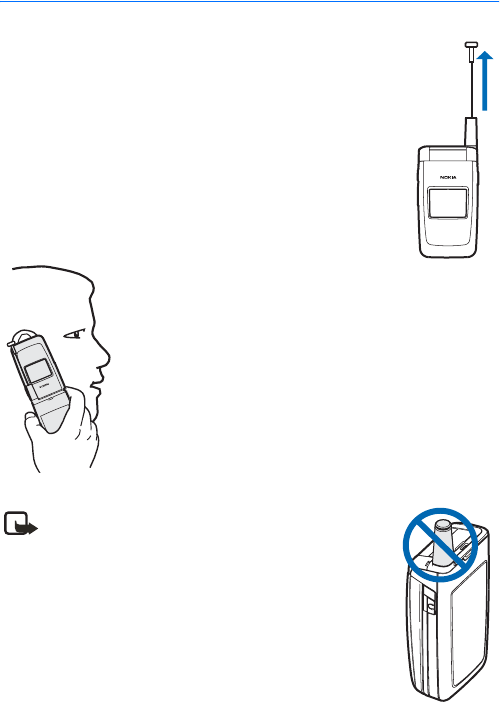
Set up your phone
15
2. Set up your phone
■Antenna
Your device has two antennas: the fixed antenna is active unless
the extendable antenna is fully extended.
In the Nokia 3155i phone, the GPS antenna is internal and is
activated when placing emergency calls or when On is selected
from the Location info sharing menu (a carrier-dependent
feature). See "Location info sharing," p. 54.
Your device has a fixed and extendable antenna located
towards the top of the phone with the fold closed. Hold the
phone with the antenna area pointed up and over your
shoulder.
Note: As with any other radio transmitting device, do
not touch the antenna unnecessarily when the
device is switched on. Contact with the antenna
affects call quality and may cause the device to
operate at a higher power level than otherwise
needed. Avoiding contact with the antenna area
while operating the device optimizes the antenna
performance and the battery life.
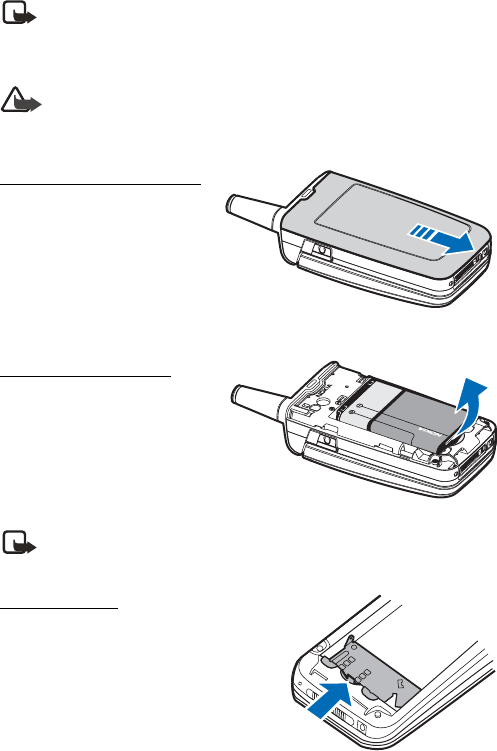
Set up your phone
16
■Change the battery
Note: Always switch the device off, and disconnect the charger and any
other device before removing the cover or the battery. Avoid touching
electronic components while changing the cover or the battery. Always
store and use the device with the cover attached.
Warning: Use only batteries, chargers, and enhancements approved by
Nokia for use with this particular model. The use of any other types may
invalidate any approval or warranty and may be dangerous.
Remove the back cover
1. With the back of the phone
facing you, push down on the
back cover.
2. Slide the back cover toward
the bottom of the phone and
remove.
Remove the battery
After you have removed the back
cover, insert your finger into the
finger grip, and lift the battery
from its compartment.
Note: Always switch off the device, and disconnect the charger before
removing the battery.
UIM card slot
Your phone has a UIM (CDMA SIM) card slot
built into the mechanics. However, the UIM
is not functional in this phone model. Avoid
placing anything into the UIM card slot.
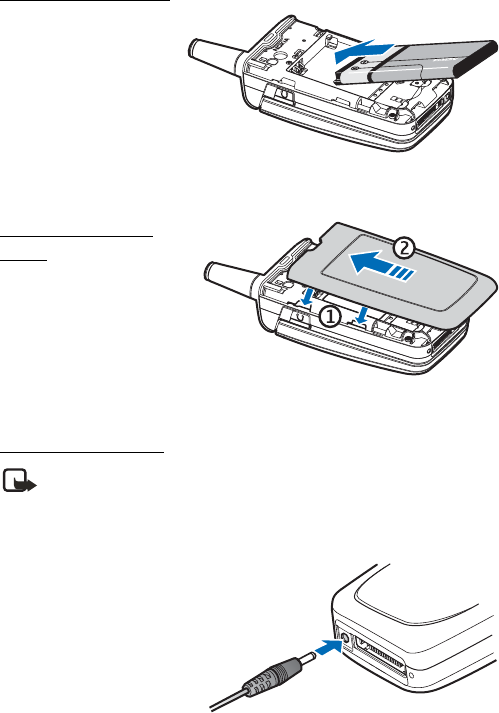
Set up your phone
17
Replace the battery
1. Insert the battery, gold
colored contact end
first, into the battery
slot.
2. Push down on the other
end of the battery to
snap the battery into
place.
Replace the back
cover
1. Set the back cover on the
phone with the cover tabs
aligned with the slots in
the phone.
2. Slide the back cover
toward the top of the phone until the back cover is securely in place.
Charge the battery
Note: Check the model number of any charger before use with this
device. This device is intended for use when supplied with power from
the AC-3 or AC-4 charger.
1. Plug the charger transformer into a standard ac outlet.
2. Insert the charger output
plug into the round jack at
the bottom end of the
phone.
After a few seconds, the
battery indicator in the
display starts to scroll from
bottom to top. If the
battery is completely discharged, it may take a few minutes before the
charging indicator appears on the display or before any calls can be made.
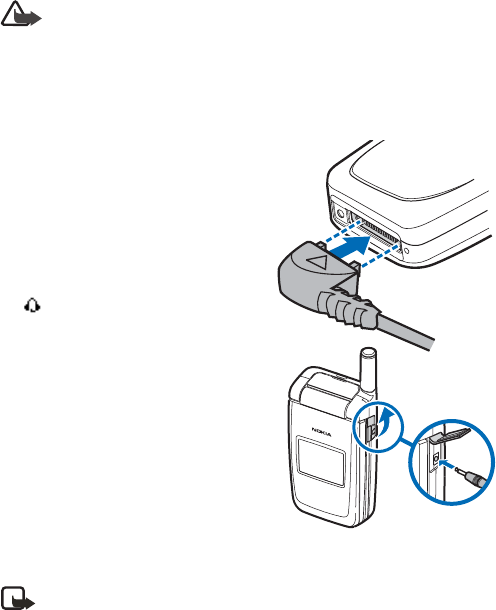
Set up your phone
18
For availability of approved enhancements, please check with your dealer.
When you disconnect the power cord of any enhancement, grasp and pull the
plug, not the cord.
■Turn your phone on or off
1. To turn your phone on or off, press and hold the end key for at least 4 seconds.
2. Enter the lock code, if necessary, and select OK. See "Change lock code," p. 65.
Warning: Do not switch the phone on when wireless phone use is
prohibited or when it may cause interference or danger.
■Connect the headset
A compatible headset, such as HS-5 or HS-9, may be purchased with your phone,
or separately as an enhancement. See "Enhancements," p. 84.
1. Plug the HS-5 headset connector into
the Pop-Port connector at the bottom
end of your phone or, plug the HS-9
headset connector into the 2.5 mm
headset jack located on the side of
your phone to allow hands-free
operation.
appears in the standby mode.
2. Position the headset on your ear.
With the headset connected, you can
make, answer, and end calls as usual.
• Use the keypad to enter numbers.
• Press the call key to place a call. See
"Phone at a glance," p. 10.
• Press the end key to end a call.
■Make a call
Note: Before making or receiving a call, fully extend the whip antenna.

Set up your phone
19
Keypad
1. Enter the phone number (including the area code), and press the call key. (To
delete a character to the left of the cursor, select Clear.)
2. Press the end key to end the call, or select End call to cancel the call attempt.
Contacts list
1. In the standby mode, scroll down to display your contacts list and highlight
your desired entry.
2. Select Details to highlight your desired number, then Call.
Last outgoing number
1. In the standby mode, press the call key to display the last 30 numbers dialed.
2. Scroll to the number (or name) you want to redial, and press the call key.
Conference calling
Conference calling is a network service that allows you to take part in a
conference call with two other participants.
1. Make a call to the first participant.
2. With the first participant on the line, select Options > New call.
3. Enter the phone number of the second participant, or select Search to
retrieve a number from the contacts list. Select Call. The first participant is
put on hold.
4. When the second participant picks up, press the call key to connect the calls.
5. To end the conference call, select Options > End all calls, or press the end key.
■Answer calls
Incoming calls
1. With the fold open, press the call key, or select Answer to answer the call.
2. Press the end key to reject the call.

Set up your phone
20
Select Silence to mute the ringtone, then Dismiss, or do nothing. The call is
eventually diverted to voicemail.
With your phone set to silent in the profiles menu, select Dismiss to divert the
call to voicemail.
3. With the fold closed, press the volume key to mute the ringtone.
A short press of the voice key answers an incoming call with the loudspeaker.
By default, your phone answers an incoming call when you open the fold. You can
change the setting to not answer the call when the fold opens.
In the standby mode, select Menu > Settings > Call > Answer when fold is
opened > On or Off.
Adjust the earpiece volume
Whether in or out of a call, you can scroll the volume key up or down to adjust
the volume of the earpiece. When you adjust the volume, a bar chart indicates
the volume level.
Answer with locked keypad
To answer a call with the keypad locked, press the call key with the fold open. To
answer a call with the fold closed and the keypad locked, press and hold the voice
key to answer with the loudspeaker. During the call, all features function as
normal. When you end or reject the call, the keypad automatically re-locks. See
"Keyguard," p. 21.
When the keypad lock is on, calls still may be possible to the official emergency
number programmed into your device. Enter the emergency number, and press
the call key.
The loudspeaker
Warning: Do not hold the device near your ear when the loudspeaker is
in use, because the volume may be extremely loud.
You can use your phone as a loudspeaker during a call.
• To activate the loudspeaker while in a call with the fold open, select Loudsp..
• To activate the loudspeaker when answering a call with the fold closed, press
the voice key.
• To deactivate the loudspeaker during a call, with the fold open, select Normal.

Set up your phone
21
The loudspeaker is deactivated automatically when a call (or a call attempt) ends
or when certain enhancements are connected.
Options during a call
Many of the options you can use during a call are network services. Check with
your wireless service provider for more information.
1. Select Options during a call to display the following options:
Loudspeaker or Handset—Activate or deactivate the loudspeaker while in a
call.
New call—Initiate a conference call. See "Conference calling," p. 19.
Save—Save a number while in a call to your contacts list. This option is
available only when entering numbers during a call.
Add to contact—Add a phone number to an existing contact in your contacts
list while in a call. This option is available only when entering numbers during
a call.
End all calls—Disconnect from all active calls.
Touch tones—Enter the numbers, and select Tones to send the numbers as
tones.
Contacts—View the contacts menu.
Menu—View the phone menu.
2. Scroll to and select an option to activate the option or enter its submenu.
■Keyguard
With keyguard, you can lock the keypad to prevent keys from being pressed
accidentally. The locked keypad unlocks when you receive a call. After the call,
the lock automatically reactivates.
With the keyguard on, calls may be possible to the official emergency number
programmed into your phone. Enter the emergency number, and press the call
key.
Lock the keypad
In the standby mode, select Menu with the center selection key; then press *
within 2 seconds.

Set up your phone
22
Unlock the keypad
Select Unlock with the center selection key; then press * within 2 seconds.

Text entry
23
3. Text entry
You can use two methods for entering text and numbers: standard mode and
predictive text mode.
• Select Clear to backspace the cursor and delete a character.
• Select and hold Clear to backspace continuously and delete multiple
characters.
■Standard mode
Standard mode is the only way to enter text into the contacts list and to rename
caller groups.
Text (Abc)
Press a key once to insert the first letter on the key and twice for the second
letter, etc. If you pause briefly, the last letter in the display is accepted and your
device awaits the next entry.
•Press 0 to enter a space and accept a completed word.
•Press 1 to insert a period into your message.
•Press and hold * to display a complete list of special characters.
•Press and hold # to switch between letters and numbers.
Numbers (123)
To switch from Abc mode to 123 mode, press and hold # at any message entry
screen.
Punctuation and special characters
While at any text entry screen, press * to display special characters (press and
hold * if predictive text is on). Press * again to cycle through all available
characters. To navigate through the list of special characters, use the scroll keys.
Once a character is highlighted, select Insert to insert the character into your
message.
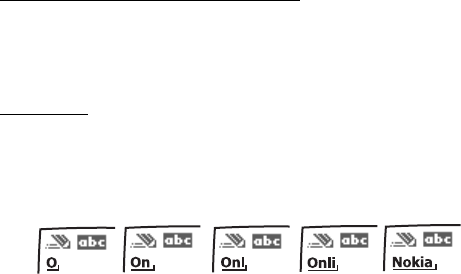
Text entry
24
■Predictive text mode
To write messages quickly, use predictive text mode with your keypad and the
built-in dictionary. Predictive text mode is much faster than the standard mode
method because you do not need to scroll through the letters on each key to spell
a word. The dictionary determines which word to enter based on the keys
selected.
Language selection and activation
You can select the language that predictive text uses. At any text entry screen,
select Options > Writing language > English or Français. To activate predictive
text, at any text entry screen, select Options > Dictionary on.
Text entry
The illustration below simulates your display each time a key is pressed. For
example, to write ’Nokia’ with predictive text on and the English dictionary
selected, press each of the following keys:
6 6 5 4 2
• Press 0 to enter a space, and begin writing the next word.
• If a displayed word is not correct, press * to see other matches. To return to
the previous word in the list of matches, select Previous.
•If ? appears after a word, select Spell to enter the word with the standard
mode, and add the word to the dictionary.
• Press 1 to insert a period into your message.
• Press and hold * to display special characters. Press * again to cycle through
all available characters.
■Change case and mode
Press # to switch between uppercase, lowercase, and sentence case text and
between standard and predictive text mode. Case and mode are indicated by the
icons that appear in the upper left of the display screen, as follows:

Text entry
25
Uppercase text: standard mode is on.
Lowercase text: standard mode is on.
Sentence case text: standard mode is on. This option is available only
at the beginning of a sentence.
Uppercase text: predictive text is on.
Lowercase text: predictive text is on.
Sentence case text: predictive text is on. This option is available only
at the beginning of a sentence.

My account
26
4. My account
You can access your Virgin Mobile account to check or increase your balance. To
access your account, select Menu > My Account.

Call history
27
5. Call history
Call history stores information about your last 30 missed, incoming, and
outgoing calls. When the number of calls exceeds the maximum, the most recent
call replaces the oldest.
Whether viewing missed, incoming, or outgoing calls, select from the following
options:
Time of call—Displays the date and time of the call.
Send message—Sends a message to the number.
Use number—Edits the number and associates a name with the number.
Save—Enters a name for the number and saves it to your contacts list.
Add to contact—Adds a number to a contact and saves it to your contacts list
(available only with numbers not yet stored in your contacts list).
Delete—Clears the number from memory.
Call—Calls the number.
Note: You cannot make calls from Call History to entries identified as
restricted.
■View missed calls
The missed calls feature does not function with your device switched off. Missed
calls are calls you have never answered. To view missed calls, do the following:
1. In the standby mode, select Menu > Call History > Missed calls; or, when the
missed call notification is displayed, select List.
2. Scroll to a name or number, and select Options and an option to view or
activate.
■View incoming calls
Incoming calls are calls that have been answered.
1. In the standby mode, select Menu > Call History > Incoming calls.
2. Scroll to a name or number, and select Options and an option to view or
activate.

Call history
28
■View outgoing calls
Outgoing calls are previous numbers you have dialed from your device:
1. In the standby mode, press the call key; or select Menu > Call History >
Outgoing numbers.
2. Scroll to a name or number, and select Options.
3. Select an option to view or activate.
■View call times
You can make or receive calls to or from the same number and view up to five
calls displayed with the time each call occurred. Your device clock must be set for
this feature to work accurately.
1. In the standby mode, select Menu > Call History > Missed calls, Incoming
calls, or Outgoing numbers.
2. Highlight your desired name or number, and select Options > Time of call.
3. Scroll down to view the call times from this number; select Back to return to
the options list.
■Delete recent call list
You can delete any missed, outgoing, or incoming calls from your device memory.
1. In the standby mode, select Menu > Call History > Delete recent calls.
2. Select the call type you want to clear: All, Missed, Incoming, or Outgoing.
■Save phone number from call history
Your phone can store up to 500 contact entries and each contact entry can store
up to 5 phone numbers. To save a phone number from Call History do the
following:
1. Select the Call History entry.
2. Select a number and Options > Save.
3. Type in the new entry name, and select OK.
Note: You cannot save phone numbers from calls identified as
restricted.
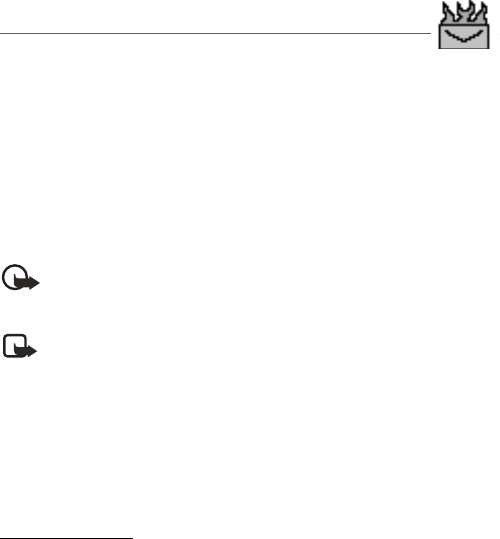
Messages
29
6. Messages
If you have subscribed to a message network service, you can send and receive
messages to compatible phones also subscribed to a message service. You can
make distribution lists that contain phone numbers and names from your
contacts list.
When composing text messages, check the number of characters allowed in the
top right corner of the message. Using Unicode characters takes up more space.
With Unicode characters in your message, the indicator may not show the
message length correctly. Before sending the message, the phone tells you if the
message exceeds the maximum length allowed for one message.
Important: Exercise caution when opening messages. Messages may
contain malicious software or be otherwise harmful to your device or
PC.
Note: When you send a message, your device may display Message sent.
This is an indication that the message has been sent by your device to the
message center number programmed into your device. This is not an
indication that the message has been received at the intended
destination. For more details about messaging services, check with your
service provider.
■Text messages
Write and send
1. In the standby mode, select Menu > Messages > Text messages > Create
message.
To go quickly to Create message, scroll left in the standby mode.
2. Compose and send a message using the keypad.
Depending on the messaging service enabled, some or all of the following
options are available while composing your message:
Sending options—Mark or Unmark the sending options of a single message as
Urgent, Callback no., or Signature. See "Change sending options," p. 34.
Clear text—Erase all the text from the message editor.
Insert contact—Insert a name from your contacts list into your message.

Messages
30
Insert number—Insert a phone number or find a phone number in the
contacts list.
Save message—Select Drafts to save the message in the drafts folder; select
Templates to save the message as one of your predefined templates in the
templates folder.
Exit editor—Exits the message editor.
Use template—Insert a predefined template into your message.
Insert smiley—Insert a smiley into your message.
Insert word—Enter a word and insert it into your message. This option is
available if predictive text is turned on.
Insert symbol—Insert a special character into your message. this option is
available if predictive text is turned on.
Writing language—Choose the language you want to use.
Dictionary on or Dictionary off—Turn the predictive text on or off.
3. To send the message, select Send to > Send to number, Send to distrib. list (if a
distribution list has been created), Send to e-mail, or Send to many. Enter the
recipient’s phone number or e-mail, or select Search to retrieve a number
from your contacts list; select OK.
Read message
When you receive a message, a notification message and are displayed.
1. Select Show to read the message or Exit to dismiss the notification and read
the message later from your inbox. See "View saved messages," p. 32.
2. Scroll up or down to view the whole message, if necessary.
Reply to message
1. In the standby mode, select Menu > Messages > Text messages > Inbox and
your desired message, or when you receive a message, select Show.
2. Select Reply > Empty screen, Original text, Template, or one of the predefined
answers. Compose your reply using the keypad.
3. After creating the reply, select Send. The sender’s phone number or e-mail is
used as the default.

Messages
31
Canned messages
Canned messages or templates are short, prewritten messages you can recall and
insert into new text messages when you are short on time. See "Canned
messages," p. 31.
1. In the standby mode, select Menu > Messages > Text messages > Create
message > Options > Use template.
2. Select your desired template.
3. Select Send to > Send to number, Send to many, Send to e-mail, or Send to
distrib. list (if a distribution list is created).
4. Enter the recipient’s phone number or e-mail, or select Search to retrieve a
number from your contacts list; select Send.
The following canned messages are available:
• Where u at?
• What up?
• B there soon
•Tipsy?
• I’m gonna B late
• What’s the 411?
•R U up 4 it?
• U know u want me
• Let’s jet
•Whatever
Message folders
Save messages
You can save drafts of messages or received messages to an existing folder or to a
folder that you have created.
1. Open the received message or create a new message, and select Options.
2. To save a received message, select Save > Archive, Templates, or a folder you
have created.
Messages
32
3. To save the draft of a message you have created, select Save message > Drafts
or Templates.
View saved messages
1. In the standby mode, select Menu > Messages > Text messages.
2. Select the folder that contains the message you want to view:
Inbox—Automatically stores any incoming messages
Outbox—Stores messages that have not been sent
Sent items—Stores messages that have been sent
Drafts—Stores messages created as drafts
Archive—Stores messages that you choose to archive, including unread ones
Templates—Stores prewritten templates. Preloaded templates can be edited
and customized.
My folders—Allows you to organize your messages by creating custom folders
and saving some of your messages here. Select My folders to add a custom
folder, or rename or delete a folder you have created.
You can only delete folders created in my folders; the inbox, sent items,
archive, and templates folders are protected. When deleting a folder, you are
also deleting all messages in the folder.
Distribution lists—Stores created distribution lists.
3. When the folder opens, select the message you want to view.
Distribution list
The distribution list enables you to send messages to a group of contacts. In the
standby mode, select Menu > Messages > Text messages > Distribution lists.
To create a distribution list, select New list with no list created or Options >
Create new list to create additional lists. To populate your list, select Add new and
a contact from your contacts list.
To use, rename, or modify a distribution list, highlight the distribution list; and
select Options > Send message, Rename list, Clear list, or Delete list.
A distribution list only contains phone numbers of recipients and is selected from
a list of predefined groups you create.

Messages
33
Delete messages
If your message memory is full and you have more messages waiting at the
network, No space for new text messages appears in the standby mode. You can
do the following:
• Read some of the unread messages, and delete them individually.
• Delete messages from some of your folders.
Delete a single message
1. In the standby mode, select Menu > Messages > Text messages.
2. Select the folder containing the message you want to delete.
3. Highlight the message you want to delete.
4. Select Options > Delete.
5. Select Yes to delete the message or No to exit.
Delete messages in a folder
1. In the standby mode, select Menu > Messages > Text messages > Delete
messages.
2. Select the messages you want to delete:
All—Deletes all messages in all of the folders
All read—Deletes any messages that have been read in all of the folders
All unread—Deletes any messages that have not been read in all of the folders
3. Select and Mark the folders that have messages you want to delete:
Inbox—Deletes all messages from the inbox folder
Sent items—Deletes all messages from the Sent items folder
Outbox—Deletes all messages from the outbox folder
Drafts—Deletes all messages from the drafts folder
Archive—Deletes all messages from the archive folder
User defined folders—Deletes all messages from the user defined folder
4. Select Done > Yes to empty the marked folder.

Messages
34
Message settings
Change sending options
To change sending options for all future text messages, in the standby mode,
select Menu > Messages > Text messages > Message settings > Sending options
and the setting you want to change:
Priority—Set the priority of the note as Normal or Urgent.
Send callback number—Send a callback number to the recipient. Select Off or
enter your desired phone number to send to the recipient as a callback number,
and select OK.
Signature—Select On to create a signature to send with text messages or Off to
turn this feature off.
To change sending options for one message, in the standby mode, select Menu >
Messages > Text messages > Create message > Options > Sending options, and
Mark or Unmark the setting you want to change:
Urgent—Set the priority of the note as Urgent.
Callback no.—Enter your desired phone number to send to the recipient as a
callback number, and select OK.
Signature—Create a signature to send with text messages.
Other settings
to change the Message font size, Incoming msg. display, or to Save sent
messages, from the standby mode, select Menu > Messages > Text messages >
Message settings > Other settings. You can also select:
Message overwriting—To determine how and whether messsages will be
automatically overwritten when the message memory is full
Queue msgs. when digital unavailable—To store in outbox messages that can be
sent later when digital service is available
Change message settings
You can change the settings of a message. In the standby mode, select Menu >
Messages > Text messages > Message settings > Other settings and the setting
you want to change:
Message font size—Select Small font or Large font.
Message overwriting—To determine how and whether messsages will be
automatically overwritten when the message memory is full, select Sent items
only, Inbox only, S. items & Inbox, or Off.

Messages
35
Note: When the message memory is full, your phone cannot send or
receive any new messages. To free up the memory, you can select
Message overwriting to make your phone automatically replace old
messages in the inbox and outbox folders when new ones arrive.
Save sent messages > Always save, Always prompt, or Off.
Queue msgs. when digital unavailable > On, On prompt, or Off—To store in outbox
messages that can be sent later when digital service is available.
■Voice messages
If you subscribe to voice mail, all unanswered calls are automatically transferred
to your voicemail even if your phone is in use or turned off. Your wireless service
provider will furnish you with a voice mailbox number. You need to save this
number to your device to use voicemail.
When you receive a voice message, your device beeps, displays a message, or
both. The voice mail icon is also displayed in the upper left corner of the mini
display when the flip is closed and you are in power-save mode. If you receive
more than one voice message, your device shows the number of voice messages
received.
Set up your voice mail
Set up your voicemail and personal greeting as soon as your phone is activated.
1. From the standby mode, press and hold 1.
2. Follow the prompts to create your pass code and record your greetings.
Listen to voice messages
In the standby mode, press and hold 1; or select Menu > Messages > Voice
messages > Listen to voice messages to dial the voice mailbox number. When you
connect and the prerecorded greeting begins, follow the automated instructions
to listen to your voice messages.
To listen to voice messages from a phone other than the Nokia 3155i:
1. Dial your cell phone number.
2. When your voicemail answers, press and hold 1.
3. Enter your pass code.

Messages
36
Clear voice mail icon
To clear the voice mail icon from the display, in the standby mode, select Menu >
Messages > Voice messages > Clear voice message icon.
Automate voice mail
Special characters, called dialing codes, can be added to phone numbers. Dialing
codes instruct the receiving system to pause, wait, bypass, or accept the numbers
that follow them in the dialing string. See "Insert dialing codes," p. 37.
Voice mail services vary by service provider. The following instructions are
examples of common operations. Please check with your service provider for
specific instructions for using your voice mail service.
Set up voice mail with dialing codes
1. Write down your voice mailbox number.
2. Call and check your voice mail as you normally would.
3. Write down your interaction with the recorded prompts step-by-step. Keep in
mind that each voice mail service may vary. However, it should be similar to
the following:
Dial 2145551212, pause 5 seconds, press 1, pause 2 seconds, press 1234,
press #.
4. In the standby mode, select Contacts > Speed dials.
5. Scroll to an (empty) 1-touch dialing slot, and select Assign.
6. Enter your voice mailbox number, including the area code.
7. Enter any dialing codes as necessary using the information that you wrote
down.
If you pause for 5 seconds after connecting to voice mail, enter p twice after
the voice mailbox number; for example, 2145551212pp.
8. Enter any remaining pauses or other information that allow you to listen to
your messages, and select OK.
9. Enter a name (such as voice mail), and select OK.
To dial and listen to your voice mail, in the standby mode, press and hold the
assigned 1-touch dialing key.
Messages
37
Insert dialing codes
Press * repeatedly to cycle through the dialing codes. Once the desired code
appears in the display, pause briefly. The code is inserted into the dialing string.
The following dialing codes are available:
* —Bypasses a set of instructions
+—International prefix
p—Pauses for 2.5 seconds before sending the numbers that follow
w—Waits for you to press the call key before sending the numbers or codes that
follow
■E-mail
E-mail is a network service. See "Network services," p. 6. If your wireless service
provider supports this feature, you can use the e-mail message to access the
e-mails. In the standby mode, select Menu > Messages > E-mail.
■VXL
VXL is a network service. See "Network services," p. 6 and "VXL," p. 79.
If your wireless service provider supports this feature, you can use the VXL to
access the Web. In the standby mode, select Menu > Messages > VXL.

Contacts
38
7. Contacts
The contacts list can hold up to 500 contacts with multiple numbers and text
notes for each contact. The amount of numbers and text entries you can save
may vary, depending on the length and total number of entries in the contacts
list.
■Names
Add new contacts
To access the contacts list in the standby mode, press the right selection key, or
select Menu > Contacts > Names if the right selection key on your device has a
network operator menu.
Save contact name and number
1. In the standby mode, enter the phone number you want to save.
2. Select Save.
3. Enter the name, and select OK.
Save contact number only
1. In the standby mode, enter the phone number you want to save.
2. Select and hold Options.
Save an entry
1. In the standby mode, select Menu > Contacts > Names > Options > Add new.
2. Enter the name, and select OK.
3. Enter the phone number, and select OK > Back.
Save numbers and text items
You can save different types of phone numbers and short text items per name to
the contacts list. The first number you save for any entry is automatically set as
the default or primary number, which you can always change.
1. In the standby mode, scroll down to display your contacts list, and highlight
the entry to which you want to add a phone number or text item.

Contacts
39
2. Select Details > Options > Add detail > Number (General, Mobile, Home,
Work, or Fax), E-mail address, Web address, Street address, Note, Image, or
Tone.
3. Enter the number or text for the type you have selected, and select OK.
4. To change a number type (General, Mobile, Home, Work, or Fax), highlight the
number, and select Options > Change type.
Change default number
You can also change which phone number is the default (primary) number for the
contact entry.
1. In the standby mode, scroll down to select the contact entry you want to
change, and select Details.
2. Scroll to the number you want to set as default, and select Options > Set as
default.
Edit contacts list entries
1. In the standby mode, scroll to the entry you want to edit in your contacts list.
2. Select Details > Options.
3. Select one of the following options, which may vary depending on whether
you are editing a contact listed by phone number or contact name:
View—View the phone number of the contact.
Add detail—Add more details to the contact: Name (only available with no
name added), Number (General, Mobile, Home, Work, or Fax), E-mail address,
Web address, Street address, Note, Image (only available with no image
added), or Tone.
Edit name, Edit number, Edit detail, or Change image—Edit an existing
contact name, phone number, details, or image attached to the contact.
Delete—Delete more details (Delete number, Delete detail, or Delete image) or
the entire contact entry (Delete contact) of the contact.
Send message—Create and send the contact a text message.
Use number—Use or save the number (available when you select a contact
listed with a contact name). Select Options to use the number.
Set as default—Change the default number of the contact.

Contacts
40
Change type—Change the number type to General, Mobile, Home, Work, or
Fax.
Add voice tag or Voice tag—Add a voice tag to the contact with no voice tag
assigned, or select Playback, Change, or Delete with a voice tag assigned.
Send bus. card—Send the contact as a business card to another device.
Caller groups—Add the contact to an existing caller group.
Speed dial—Add the contact to your 1-touch dialing list.
4. Edit the option to your preference, and select OK.
Access the contacts menu
1. In the standby mode, select Menu > Contacts and one of the following
options:
Names—View the entries in your contacts list, and select Details or Options >
Search, Add new, or Delete contact for your selected entry.
Settings—Change the contacts list view or check the memory status of your
device.
Caller groups—View and edit the properties of any of the caller groups,
including Family, VIP, Friends, Business, or Other.
Voice tags—Listen to, modify, or delete a voice tag to a contact in the
contacts list.
1-touch dialing—View or modify the list of 1-touch dial numbers.
My numbers—View your own phone number.
Delete all contacts—Delete all entries in your contacts list.
2. Select an option to activate the feature or access its submenu.
Search for a name
1. In the standby mode, scroll down to display the contents of your contacts list.
2. Press the key corresponding to the first letter of the name for which you are
searching.
3. Scroll to select a contact, and select Details to view the details.

Contacts
41
Send and receive contacts
You can send and receive an entry in your contacts list using text messaging, if
supported by your wireless service provider.
Send a business card
You can send a business card as a text message to a compatible phone or other
handheld device.
1. Highlight the desired entry from your contacts list, and select Details >
Options > Send bus. card > Via text message > Primary number and All details
options appear only if you have more than one number or detail saved to the
contact entry.
2. Enter the number for your recipient, or select Search to retrieve a number
from your contacts list.
3. Select OK and the business card is sent.
■Settings
Configure settings
You can select how the contacts appear in your contacts list and view the
amount of memory used or available in your device.
In the standby mode, select Menu > Contacts > Settings > Scrolling view to
change view of name list or Memory status to view the device memory used and
remaining.
■Caller group
Caller groups
You can add contacts list entries to any of five caller groups, and assign a unique
ringtone or graphic to that group. This enables you to identify callers from the
group by their unique ringing tone or graphic.
To assign an entry in your contacts list to a caller group, scroll to your desired
contact entry, and select Contacts > Caller groups > Family, VIP, Friends,
Business, or Other.

Contacts
42
To manage your caller groups, in the standby mode, select Contacts > Caller
groups > Family, VIP, Friends, Business, or Other to display the following caller
group options:
Rename group—Rename the group to your preference.
Group ringtone—Set the ringtone for the group.
Group logo—Turn the graphic for the caller group On or Off, or View the graphic.
Group members—Add or remove members from the caller group.
■Voice tags
Voice tags
You can dial up to 25 stored numbers using voice dialing.
Before using voice tags, note the following:
• Voice tags are not language-dependent. They depend on the speaker’s voice.
• You must say the name exactly as you said it when you recorded it.
• Voice tags are sensitive to background noise. Record voice tags, and use them
in a quiet environment.
• Very short names are not accepted. Use long names and avoid similar names
for different numbers.
Note: Using voice tags may be difficult in a noisy environment or during
an emergency, so you should not rely on voice dialing in all
circumstances.
Assign a voice tag to an entry
Before you can use voice dialing, you must first assign a voice tag to the number.
1. In the standby mode, scroll to the entry in your contacts list to which you
want to assign a voice tag.
2. Select Details > Options > Add voice tag > Start.
3. Speak clearly into the microphone. Do not select Quit unless you want to
cancel the recording. The device automatically stops recording, and saves and
replays the voice tag. appears next to commands that have voice tags
assigned.

Contacts
43
Dial a number
1. In the standby mode, press and hold the right selection key with the fold
open, or press and hold the voice key regardless of whether the fold is open or
closed.
2. When you hear several beeps and Speak now appears, release the key.
3. Pronounce the voice tag clearly into the microphone.
When the device finds the voice tag, Found: is displayed, and the device
automatically dials the number. If the device does not locate a number or
recognize the voice tag, No match found is displayed.
Voice tags
1. After you have associated a voice tag to a contact, select Menu > Contacts >
Voice tags and your desired voice tag entry.
2. Select Playback, Change, or Delete.
■1-touch dial
Set up 1-touch dialing
You can associate any entry in the contacts list with a key from 2–9. To dial those
entries, press and hold the assigned key. See "Speed dialing," p. 56 to activate or
deactivate speed dialing.
Assign a key to 1-touch dialing
1. In the standby mode, select Menu > Contacts > 1-touch dialing.
2. Scroll to an (empty) 1-touch dialing slot, and select Assign.
3. Enter the number (including the area code) and a name for the number, and
select OK; or select Search to retrieve a number from the contacts list.
If 1-touch dialing is off, the device displays a prompt and asks if you want to
turn 1-touch dialing on.
4. Select Yes to activate 1-touch dialing.
Change 1-touch dialing numbers
1. In the standby mode, select Menu > Contacts > 1-touch dialing.
2. Scroll to the 1-touch dialing entry you want to change, and select Options >
Change.
Contacts
44
3. Enter the new number and a name for the entry, and select OK; or select
Search to retrieve a number from the contacts list.
Delete 1-touch dialing numbers
1. In the standby mode, select Menu > Contacts > 1-touch dialing.
2. Scroll to the 1-touch dialing entry you want to delete, and select Options >
Delete > Yes.
■My numbers
To display your own phone number, from the standby mode, select Menu >
Contacts > My numbers.
■Delete all contacts
To delete all entries in your contacts list, in the standby mode, select Menu >
Contacts > Delete all contacts.

My stuff
45
8. My stuff
You can use My Stuff to store downloaded games, tones, images, and
applications.
Your device has a limited amount of memory for storing files in My Stuff. This
memory is not shared with other functions, such as contacts. If the device
displays a message that the memory is full, delete some existing files before
proceeding.
■Games
Challenge yourself or a friend to one of the fun games in your phone. Some
menus listed are network services. In the standby mode, select Menu > My Stuff
> Games > Get new to download a new game or Content manager to ...
Play a game
1. In the standby mode, select Menu > My Stuff > Games > and a downloaded
game.
2. Select a game, Options > Open, and one of the following options (if supported
by the particular game):
New game—Launch a new game.
High scores—View the high scores for this game (if previously played).
Instructions—View instructions for playing the game. Scroll down to read
more.
Game settings
In the standby mode, select Menu > My Stuff > Games and one of the following
game submenus:
Get new—Enter a game option list. See "Game details," p. 46.
Memory—Check the available memory for games and game-related applications.
Settings—Turn Game sounds, Game lights, and Shakes on or off.

My stuff
46
Game details
To display the name, version, and size of a selected game, select Options >
Details.
■Tones
Tones to use as ringtones or attach to a contact entry or message can be stored in
or retrieved from this folder. In the standby mode, select Menu > My Stuff >
Tones to open the tones folder.
■Images
Images used as screensavers identify a contact entry or, attached to a message,
can be stored in or retrieved from this folder. In the standby mode, select Menu >
My Stuff > Images to open the images folder.
■Applications
Applications that are downloaded from VXL can be stored in or retrieved from
this folder. In the standby mode, select Menu > My Stuff > Applications to open
the applications folder.
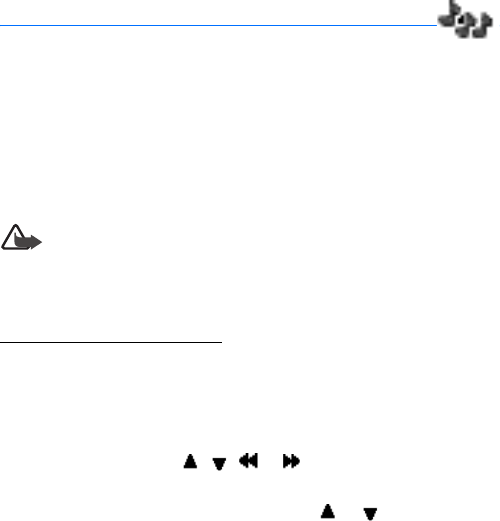
Tunes
47
9. Tunes
■Radio
Your phone has an FM radio that also functions as an alarm clock radio. To listen
to the FM radio on your phone, connect a compatible music stand or stereo
headset to the connector on the bottom of the phone. The FM radio uses the wire
of the headset as an antenna. A compatible headset needs to be attached to the
device for the FM radio to function properly. The quality of a radio broadcast
depends on coverage of the radio station in that particular area.
Warning: Listen to music at a moderate level. Continuous exposure to
high volume may damage your hearing. Do not hold the device near your
ear when the loudspeaker is in use, because the volume may be
extremely loud.
Turn the radio on and off
1. Connect the phone to a compatible headset or music stand.
2. In the standby mode, select Menu > Tunes > Radio. The channel location
number, the name of the radio channel (if you have saved the channel), and
the frequency of the radio channel are displayed.
To use the graphical keys , , , or on the display, scroll left or
right to the desired key, and select it.
3. If you have already saved radio channels, select or to scroll to the
channel you would like to listen to.
To select a radio channel location, briefly press the corresponding number
keys.
4. To turn off the radio, press and hold the end key, or select Options > Turn off.
Options
With the radio on, select Options and one of the following:
Turn off—Turn off the radio.
Save channel—Save the current station to one of 20 locations (only available
with a new station entered).

Tunes
48
Channels—Scroll up or down to select a channel from 20 locations. With an
existing channel highlighted, select Options > Delete channel or Rename to
delete or rename the saved channel.
Mono output or Stereo output—Listen to the radio in monaural mode (default) or
in stereo. Stereo output is available through a stereo enhancement.
Loudspeaker or Headset—Listen to the radio through the speakerphone or
through the headset.
Set frequency—Manually enter the frequency of a known radio station.
To set the radio frequency, press * and use the keypad to enter the frequency of a
known radio station.
To adjust the radio volume, press the volume up and down keys.
When an application using a browser connection is sending or receiving data, it
may interfere with the radio.
When you place or receive a call, the radio automatically mutes. When the call
ends, the radio switches back on.
Tune and save a radio channel
You can save a preset station to any one of 20 locations in memory.
1. With the radio on, select or to change the radio frequency in 0.1 MHz
steps, or select and hold or to start the channel search. Searching
stops when a channel is found.
2. To save the channel, select Options > Save channel.
3. Enter a name for the channel, and select OK.
■Recorder
This feature enables you to record pieces of speech or sound with your device and
listen to them later. The total available time is 3 minutes with no stored memos.
The maximum length of a recording depends on how much memory remains
available.
In the standby mode, select Menu > Tunes > Recorder > Record to start the
recording or Recordings list to manage the recordings stored in Tones folder .
Record speech or sound
1. In the standby mode, select Menu > Tunes > Recorder > Record.

Tunes
49
2. After you hear the recorder start tone, begin recording speech or sound.
3. When you finish recording, select Stop and your recording is saved to the
Tones folder in My stuff.
Options
After the recording is saved to the Tones folder, highlight the recording, and
select Listen to listen to the recording using the earpiece; or select Options and
one of the following.
Delete—Erase the recording.
Rename—Change the name of the recording.
Set as—Use your recording as a ringer (a carrier-dependent feature).
Details—Show the name, size, and date of creation of the recording.
■Equalizer
The equalizer enhances the sound quality when you use the music player by
amplifying or attenuating frequency bands. You can access five preset equalizer
settings (Normal, Pop, Rock, Jazz, and Classical) and two customizable settings.
Activate an equalizer set
In the standby mode, select Menu > Tunes > Equalizer, scroll to the desired
setting, and select Activate.
Create a custom equalizer set
1. In the standby mode, select Menu > Tunes > Equalizer.
2. Scroll to the set you want to edit, and select Options >
Edit.
The selected set appears in the display with the bar on
the far left highlighted. The bars adjust frequencies,
from the lowest (the leftmost bar) to the highest (the
rightmost bar). The higher the indicator on a
particular bar, the more that frequency is amplified.
3. To adjust the frequency, scroll up and down on the bar.
4. To adjust other frequencies, scroll left or right to the other bars.
Tunes
50
5. Repeat steps 3 and 4 to adjust the setting for each frequency; then select
Save.
6. To rename the setting, select Options > Rename, enter a new name, and
select OK.
7. To activate the setting, select Activate.

Settings
51
10. Settings
Use this menu to change profiles, themes, main display settings, mini display
settings, tone settings, time and date settings, call settings, phone settings, voice
commands, enhancement settings, security settings, application settings,
network settings, network services, and restore factory settings.
■Profiles
Profiles define how your device reacts when you receive a call or message and
how your keypad sounds when you press a key. You can leave ringing options,
keypad tones, and other settings for each of the available profiles at their default
setting, or customize them to suit your needs.
Profiles are also available for enhancements such as the headset and car kit. See
"Enhancements," p. 84.
To activate a profile, in the standby mode, select Menu > Settings > Profiles >
Normal, Silent, Meeting, Outdoor, or Pager > Activate.
Customize a profile
You can customize any of the profiles in various ways.
1. In the standby mode, select Menu > Settings > Profiles.
2. Select the profile you want to customize.
3. Select Customize and the option you want to customize.
Set a timed profile
You can use timed profiles to prevent missed calls. For example, suppose you
attend an event that requires your device be set to Silent before the event starts,
but you forget to return it to Normal until long after the event. A timed profile
can prevent missed calls by returning your device to the default profile at a time
you specify. You can set timed profiles up to 24 hours in advance.
1. In the standby mode, select Menu > Settings > Profiles.
2. Select the profile you want to activate and Timed for timed expiration.
3. Enter the time in hh:mm format for the profile to expire, and select OK.

Settings
52
■Tones
You can adjust the ringing volume, keypad tones, and more for the active profile.
See "Customize a profile," p. 51 for more information on profile settings.
Select Menu > Settings > Tones and one of the following:
Incoming call alert—Select how the device notifies you of an incoming call.
Video ringing tone—Select On or Off to indicate whether to replace the default
audio ringtone with the selected video.
Ringtone—Select the ringtone for incoming calls.
Ringtone volume—Set the volume of your ringtone.
Light effects—Turn the light indicator on or off with On or Off.
Vibrating alert—Turn the vibrating alert On or Off.
Message alert tone—Select the tone for received messages.
Keypad tones—Set the volume of your keypad tones (or turn them off).
Warning tones—Turn warning and confirmation tones On or Off.
Alert for—Define which caller groups the selected profile will accept or decline.
See "Caller groups," p. 41.
■Themes
Themes contains many elements you can use to personalize your phone. Themes
include wallpapers, screen savers, color schemes, and ringing tones.
To choose the skin of your display, in the standby mode, select Menu > Settings >
Themes > Select theme.
■Main display
Wallpaper
You can set your device to display a background picture (wallpaper) or slide set.
1. In the standby mode, select Menu > Settings > Main display > Wallpaper >
Select wallpaper or Slide set > Games, Tones, Images, or Applications.
2. Browse your selected folder containing the graphics or image of your desired
wallpaper.
3. When you find the image of your choice, select Options > Set as wallpaper.

Settings
53
4. To activate or deactivate wallpaper, in the standby mode, select
Menu > Settings > Main display > Wallpaper > On or Off.
Screen saver
In the standby mode, select Menu > Settings > Main display > Screen saver > On,
Off, Screen savers (Image, Slide set, or Video clip), or Time-out.
Power saver
You can turn the power saver on and off. In the standby mode, select Menu >
Settings > Main display > Power saver > On or Off.
Color schemes
You can change the color of some display components in your device, such as
indicators and signal bars.
In the standby mode, select Menu > Settings > Main display > Color schemes and
the color scheme of your choice.
Banner
If your wireless service provider supports this feature, you can choose whether
the display shows the operator logo or something else when the phone is in the
idle state.
In the standby mode, select Menu > Settings > Main display > Banner > Default
or Customize.
Backlight time-out
You can choose how long to set the backlights on. In the standby mode, select
Menu > Settings > Main display >Backlight time-out > Always on, Always off, 7
seconds, 15 seconds, or 30 seconds.
■Power savers
You can turn the power saver on and off on the main and mini displays. In the
standby mode, select Menu > Settings > Main display or Mini display > Power
saver > On or Off.

Settings
54
■Time and date settings
Clock
In the standby mode, select Menu > Settings > Time and date > Clock > Show
clock or Hide clock, Set the time, Time zone, or Time format.
Date
In the standby mode, select Menu > Settings > Time and date > Date > Show date
or Hide date, Set the date, Date format, or Date separator.
Auto-update date and time
Auto-update is a network service. See "Network services," p. 6. If your wireless
service provider supports this feature, you can allow the digital network to set
the clock, which is useful when you are out of your home area (for example when
you have traveled to another network or time zone).
In the standby mode, select Menu > Settings > Time and date > Auto-update of
date & time > On, Confirm first, or Off.
If you use the Auto-update of date & time option while outside your digital
network, you may be prompted to enter the time manually. Network time will
replace the time and date when you reenter your digital network.
If your battery has been removed or has discharged outside the digital network,
you may be prompted to enter the time manually (when the battery is replaced or
recharged and you are still outside of the digital network).
■My shortcuts
Right selection key
You can customize the right selection key in the standby mode. In the standby
mode, select Menu > Settings > My shortcuts > Right selection key.
■Call settings
Location info sharing
Location info sharing allows the device to share position information over the
network. For calls to emergency numbers, this position information may be used

Settings
55
by the emergency operator to determine the position of the device. The
functionality and accuracy of this feature are dependent on the network, satellite
systems, and the agency receiving the information. Location info sharing is a
network service. See "Network services," p. 6.
This feature may not function in all areas or at all times. This feature is not
designed to support positioning requests for related calls. Contact your service
provider for more information about how your phone complies with government
regulations on location based emergency calling services.
In the standby mode, select Menu > Settings > Call > Location info sharing >
Emergency or On > Yes or No.
Emergency—This is the default profile. The device location information is shared
only during an emergency call to the official emergency number programmed
into your device. The screen displays in the upper left hand corner in the
standby mode.
On—The device location information is shared with the network whenever the
device is powered on and activated. The screen displays in the upper left
hand corner in the standby mode.
Location information will always be shared with the network during emergency
calls to the official emergency number programmed into the device, regardless of
which setting is selected. After placing an emergency call the device remains in
emergency mode for 5 minutes. During this time, the location information will be
shared with the network. See "Emergency calls," p. 91.
With the Location Info Sharing set to only 911, some authorities can detect your
geographic location using GPS. In the standby mode, select Menu > Settings >
Location Info Sharing > 911 only.
Anykey answer
Anykey answer enables you to answer an incoming call. Briefly press any key
except the right selection key or end key.
In the standby mode, select Menu > Settings > Call > Anykey answer > On or Off.
Automatic redial
Occasionally, your network may experience heavy traffic, resulting in a fast busy
signal when you dial. With automatic redial activated, your device redials the
number (number of times is specified by the network), and notifies you when the
network is available.

Settings
56
In the standby mode, select Menu > Settings > Call > Automatic redial > On or
Off.
Speed dialing
You can activate or deactivate 1-touch dialing. In the standby mode, select
Menu > Settings > Call > 1-touch dialing > On or Off. See "Set up 1-touch
dialing," p. 43.
Automatic update of service
With automatic update of service, your device will automatically update the
service when the network is available.
In the standby mode, select Menu > Settings > Call > Automatic update of
service > On or Off.
Answer when fold is open
By default, your phone answers an incoming call when you open the fold. You can
change the default setting to have your phone not answer calls with the fold
open.
In the standby mode, select Menu > Settings > Call > Answer when fold is
opened > On or Off.
Calling card
If you use a calling card for long distance calls, you can save the calling card
numbers in your device. Your device can store up to four calling cards. Contact
your calling card company for more information.
Save information
1. In the standby mode, select Menu > Settings > Call > Calling card.
2. Enter your lock code, and select OK. See "Change lock code," p. 65.
3. Scroll to one of the four card memory locations, and select Options > Edit >
Dialing sequence and one of the following sequence types:
Access no.+ phone no.+ card no.—Dial the access number, the phone number,
then the card number (and the PIN, if required).
Access no.+ card no.+ phone no.—Dial the access number, the card number
(and the PIN, if required), then the phone number.

Settings
57
Prefix+ phone no.+ card no.—Dial the prefix (numbers that must precede the
phone number) and phone number you want to dial, then the card number
(and the PIN, if required).
4. Enter the required information (access number or prefix and card number),
and select OK to confirm your entries.
5. Select Card name, enter the card name, and select OK.
Make calls
After you have saved your calling card information in your device, you can make a
call using your calling card.
1. In the standby mode, select Menu > Settings > Call > Calling card.
2. Enter your lock code, and select OK. See "Change lock code," p. 65.
3. Select your desired calling card.
4. Press the end key to return to the standby mode; then enter the phone
number, including any prefix (such as 0 or 1) that your calling card may
require when you make a calling card call. See your calling card for
instructions
5. Press and hold the call key for a few seconds until Card call appears.
6. When you hear the tone or system message, select OK.
International prefix
You can store an international dialing prefix into your device. In the standby
mode, select Menu > Settings > Call > International prefix.
In the standby mode, when you enter + (press * twice) at the beginning of a
phone number, your device automatically inserts the international dialing prefix
that you have stored after you press the call key.
Call summary
Your device can display the time spent on a call when you hang up. In the standby
mode, select Menu > Settings > Call > Call summary > On or Off.
Ringing tone for no caller ID
You can select a different ringtone for calls received with no caller ID.

Settings
58
In the standby mode, select Menu > Settings > Call > Ringing tone for no caller
ID > On to select or change ringtone or Off.
■Phone settings
Phone language
The phone language affects the time and date formats of the clock, alarm clock,
and calendar. In the standby mode, select Menu > Settings > Phone > Phone
language and the language of your choice.
Automatic keyguard
You can set the keypad of your device to lock automatically after a preset time
delay.
1. In the standby mode, select Menu > Settings > Phone > Automatic
keyguard > On or Off.
2. If you select On, Set delay: is displayed.
3. Enter the delay time (in mm:ss format), and select OK.
When keyguard is on, it may be possible to dial the emergency number
programmed into your device.
Touch tones
Touch tones or DTMF tones are the tones that sound when you press the keys on
your device keypad. You can use touch tones for many automated dial-up
services such as banking and airlines or for entering your voice mailbox number
and password.
Touch tones are sent during an active call. Send them manually from your device
keypad, or send them automatically by saving them in your device.
Set type
In the standby mode, select Menu > Settings > Phone > Touch tones > Manual
touch tones and one of the following options:
Continuous—Used to set the tone sound for as long as you press and hold a key.
Fixed—Used to send tones of the duration you specify in the Touch tone length
option.
Off—Used to turn off tones. No tones are sent when you press a key.

Settings
59
Set length
You can specify touch-tone length for the Fixed option. In the standby mode,
select Menu > Settings > Phone > Touch tones > Touch tone length > Short
(0.1 seconds) or Long (0.5 seconds).
Start-up tone
You can select to have a start-up tone when you first turn on your device. In the
standby mode, select Menu > Settings > Phone > Start-up tone > On or Off.
Help text activation
Your device displays brief descriptions for most menu items. When you arrive at a
feature or menu, pause for about 14 seconds and wait for the help text to display.
If necessary, use the scroll key to page through the full help text.
The default setting for help text is On. However, you can turn help text on or off.
In the standby mode, select Menu > Settings > Phone > Help text activation > On
or Off.
■Voice commands
Before using voice tags, note the following:
• Voice tags are not language-dependent, but depend on the speaker’s voice.
• You must say the name exactly as you said it when you recorded it.
• Voice tags are sensitive to background noise. Record voice tags, and use them
in a quiet environment.
• Very short names are not accepted. Use long names, and avoid similar names
for different numbers.
Note: Using voice tags may be difficult in a noisy environment or during
an emergency, so you should not rely on voice dialing in all
circumstances.
Hands-free operation
You can set as many as 16 voice commands to enable hands-free operation of
certain features in your device.

Settings
60
Assign a voice tag to a command
Before using voice commands, you must first add a voice tag to the device
function.
1. In the standby mode, select Menu > Settings > Voice commands.
2. Select the device function you want to tag: Profiles, Voice mailbox, Radio,
Voice recorder or Call log.
3. If necessary, select an option associated with that function and Add.
4. Select Start, and speak the voice tag clearly into the microphone. Do not
select Quit unless you want to cancel the recording.
The device replays and saves the recorded tag. appears next to commands
with voice tags assigned.
Activate a voice command
To issue a command after you have associated a voice tag with a function in your
device, speak the voice tag.
1. In the standby mode, press and hold the right selection key or voice key.
2. With Speak now displayed, pronounce the voice tag clearly into the
microphone.
With the voice tag found, the device displays Found:, and plays the recognized
voice tag through the earpiece. The function you requested is activated.
Options
After you have associated a voice tag to a command, you can select one of the
following options:
Playback—Listen to the voice command tag.
Change—Change the voice command.
Delete—Erase the voice command tag.
■Phone details
From the standby mode, select Menu > Settings > Phone details to view the user,
version, system and icon details of your phone.

Settings
61
User details
Scroll to User details, and select one the following submenus to show user
details.
My number—Enter your mobile number.
Mobile Station ID number—000000434 is already programmed into the device
(yours will be different).
Version details
Scroll to Version details, and select one the following submenus.
Phone model—Display the model number of your phone.
Software version—Display the software version of your device.
Browser version—Display the software version of your phone web browser.
Hardware version—Display the hardware version of your device.
Icon details
Scroll to Icon details, and select one the following submenus.
3G status—Indicates whether 3G is active.
Alarm—Indicates whether the alarm in Calendar is set.
Call status —Indicates a call in progress, an incoming call or missed call.
Countdown—Indicates whether countdown timer is active.
Encryption—Indicates whether encryption is on or off.
GPS— Indicates whether GPS is on or off.
Headset —Indicates whether a headset is plugged in.
Keyguard—Indicates whether the keyguard is on or off.
Speakerphone—Indicates a call in progress, an incoming call or missed call.
Radio—Indicates whether the radio is active.
Roaming—Indicates whether roaming is on or off.
Silent mode—Indicates whether device is in silent mode.
Stopwatch—Indicates whether stopwatch is active.
Text input—Indicates that normal text will occur for current query.
Text message—Indicates that there is an unread text message in the inbox.

Settings
62
Vibrating alert—Indicates that the vibrating alert is enabled.
Voice message—Indicates that you have a new voicemail.
System details
Scroll to System details, and select one the following submenus.
System ID (SID)— Display the system ID of your phone.
Channel—Display the channel (45) of your device.
Preferred roaming list (PRL)—Display the PRL system used by your phone.
Mode—Display the mode (digital) of your device.
Icon details
■Application settings
1. In the standby mode, select Menu > Settings > Application settings.
2. Select one of the following submenus to activate options for preset or
downloaded games or applications.
Application sounds > On or Off
Application lights > App. defined or Default
Application vibration > On or Off
■Enhancements
To adjust the enhancement settings, in the standby mode, select Menu >
Settings > Enhancements > Headset, Handsfree, Loopset, TTY/TDD, Music stand,
or Charger. Some enhancement settings menu items are displayedonly if the
device has been connected to a compatible enhancement.
Headset
Important: The headset may affect your ability to hear sounds around
you. Do not use the headset in situations that may endanger your safety.
Select Headset to enter the submenu and modify its settings.
Default profile—Choose the profile you want automatically activated with a
headset connected.

Settings
63
Automatic answer—Answer calls automatically after one ring with a headset
connected. Select On or Off.
Hands-free operation
Select Handsfree to enter the submenu and modify its settings.
Default profile—Choose the profile you want automatically activated with your
device connected to a car kit.
Automatic answer—Answer calls automatically after one ring with a car kit
connected. Select On or Off.
Lights—Choose to keep the device lights always on, or to shut off automatically
after several seconds. Select On or Automatic.
Loopset
The LPS-4 loopset is recommended for use with your device. Select Loopset to
enter the submenu and modify its settings.
Default profile—Choose the profile you want to be automatically activated when
your device is connected to a loopset.
Automatic answer—Answer calls automatically after one ring when a loopset is
connected. Select On or Off.
TTY/TDD
Check with the manufacturer of the TTY/TDD device for a connecting cable that is
compatible with the Nokia device. TTY/TDD communications depend on network
availability. Check with your wireless service provider for availability and
description of services.
Charger
Select Charger to enter the submenu and modify its settings.
Default profile—Choose the profile you want automatically activated with your
device connected to the charger.
Lights—Choose to keep the device lights always on or to shut off automatically
after several seconds. Select On or Automatic.

Settings
64
■Security
When first accessing the security settings, enter the preset lock code, which is by
default, the last four digits of your phone number. If this does not work, contact
your wireless service provider for help.
Phone lock
The phone lock feature protects your device from unauthorized outgoing calls or
unauthorized access to information stored in the device. With phone lock
activated, Phone locked appears each time you turn your device on or off.
With the device locked, calls may still be possible to the official emergency
number programmed into your device.
1. In the standby mode, select Menu > Settings > Security.
2. Enter the lock code, and select OK. See "Change lock code," p. 65.
3. Select Phone lock and one of the following options:
Off—Immediately turns off the device lock feature.
Lock now—Immediately turns on the device lock feature.
On power-up—Turns on the device lock feature the next time you turn the
device on.
With Lock now selected, you must enter your lock code before the device can
function normally. With the lock code accepted, your device functions normally.
Call not allowed appears if you attempt to place a call with your device locked. To
answer a call with phone lock on, select Answer, or press the call key.
Allow numbers
With phone lock on, the only outgoing calls you can make are to the emergency
number programmed into your device (for example, 911) or the number stored in
the Allowed no. when phone locked location:
1. In the standby mode, select Menu > Settings > Security.
2. Enter the lock code, and select OK. See "Change lock code," p. 65.
3. Select Allowed no. when phone locked, an empty folder, and Assign, and enter
the phone number; or select Assign > Search to recall the number from your
contacts list. Select OK.

Settings
65
To call the allowed phone number, ensure that your phone is in the standby
mode. Scroll down to highlight the number you want to call, or enter it on the
keypad; and then press the call key to place the call.
Change lock code
The preset lock code, by default, is the last four digits of your phone number.
Depending on your wireless service provider, the preset lock code can be a four
digit number such as 1234 or 0000. If none of these work, contact your wireless
service provider for help.
To ensure the security of your device, you may want to change the preset lock
code to your own selected four digit number. Avoid using codes similar to
emergency numbers such as 911 to prevent accidental dialing of the emergency
number.
If you enter an incorrect lock code five times in a row, your device may ask you
for the security code. By default, the security code is 12345, a five-digit number.
Note: With the wrong lock code entered five times in succession, your
phone will not accept your correct lock code for 5 minutes, even if you
power off the device between incorrect entries.
1. In the standby mode, select Menu > Settings > Security.
2. Enter the lock code, and select OK.
3. Select Change lock code.
4. Enter the new lock code (must be 4 characters in length).
5. Reenter the new lock code for verification, and select OK.
When changing your lock code, make sure you store it in a safe place, away from
your device.
Call restrictions
Select call restrictions to block or allow numbers for incoming and outgoing calls.
All calls from numbers entered as blocked numbers are ignored and sent to voice
mail.
1. In the standby mode, select Menu > Settings > Security.
2. Enter the lock code, and select OK. See "Change lock code," p. 65.
3. Select Call restrictions and the types of calls you want to restrict:
Restrict outgoing calls—Set restrictions on making calls.

Settings
66
Restrict incoming calls—Set restrictions on receiving calls.
4. Select whether to block or allow numbers:
Blocked numbers—Set the numbers the phone can only block, allowing all the
rest.
Allowed numbers—Set the numbers the phone can only call or receive,
blocking all the rest.
5. Select Select, Add restriction (unavailable with memory full), Edit
(unavailable with no number added), or Delete (unavailable with no number
added).
Note: When calls are restricted, calls may be possible to the official
emergency number programmed into your device.
Voice privacy
Voice privacy is a network service. See "Network services," p. 6. If your wireless
service provider supports this feature, the voice privacy feature protects the
privacy of your current phone conversation from other callers placing phone calls
on your same network.
1. In the standby mode, select Menu > Settings > Security.
2. Enter the lock code, and select OK. See "Change lock code," p. 65.
3. Select Voice privacy > On or Off.
■Network
The Network menu enables you to customize the way your device chooses a
network in which to operate while you are within or outside of your primary or
home system. Your device is set to search for the most cost-effective network. If
your device cannot find a preferred network, it selects a network automatically
based on the option you choose in the Network menu.
The menu options you see in your device depend on your service provider’s
network. The network determines which options actually appear in the device
menu. Check with your service provider for more information.
Roaming options
You can set your device to roam or search for another network when you are not
in your home area.

Settings
67
1. In the standby mode, select Menu > Settings > Network > Roaming options
and one of the following options:
Home only—You can make and receive calls in your home area only.
Automatic A—The phone automatically searches for service in another digital
network. The roaming rate applies when not in the home service area.
Automatic B—The phone automatically searches for service in another digital
network. If one is not found, the phone uses analog service. The roaming rate
applies when not in the home service area.
2. Select OK, if necessary, to confirm the activation.
Mode
You can choose whether your device uses digital or analog service.
In the standby mode, select Menu > Settings > Network > Mode and one of the
following service options:
Digital preferred—The device works in digital mode but will also work in analog
mode with digital mode unavailable.
Analog only—The device only works in analog mode.
■Network services
The following features are network services. See "Network services," p. 6.
Call forwarding
Call forwarding tells your network to redirect incoming calls to another number.
Call forwarding is a network service and may not work the same in all networks,
so contact your wireless service provider for availability.
Activate
The following options may not all appear in the display. Contact your wireless
service provider for more information.
1. In the standby mode, select Menu > Settings > Network services > Call
forwarding > Forward all calls
2. Select Activate, enter the number, and select OK.

Settings
68
Cancel
In the standby mode, select Menu > Settings > Network services > Call
forwarding > Cancel all call forwarding. Cancel all call forwarding may affect
your ability to receive voice mail messages. Contact your wireless service provider
for specific details.
Network feature setting
This option allows you to activate network services in the phone by using feature
codes received from your service provider.
In the standby mode, select Menu > Settings > Network services > Network
feature setting, enter the code and select OK.
My number selection
This option allows you to select a specific number.
In the standby mode, select Menu > Settings > Network services > My number
selection.
■Restore settings
You can reset some of the menu settings to their original values. Data that you
have entered or downloaded is not deleted (for example, entries in your contacts
list are not affected).
In the standby mode, select Menu > Settings > Restore settings, enter the lock
code, and select OK. See "Change lock code," p. 65.
Note: Depending on your wireless service provider, your device may
sometimes ask you for the security code, instead of the lock code.
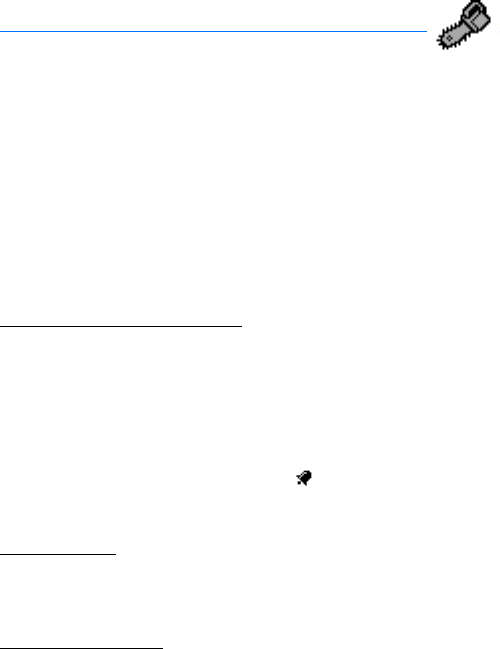
Tools
69
11. Tools
Your device contains features to help organize your everyday life, including an
alarm clock, calendar, notes, to-do list, calculator, countdown timer, and
stopwatch.
■Alarm clock
If the alarm time is reached while the device switched off, the device switches
itself on and starts sounding the alarm tone. If you select Stop, the device asks
whether you want to activate the device for calls. Select No to switch off the
device or Yes to make and receive calls. Do not select Yes when wireless phone
use may cause interference or danger.
Set or change alarm setting
The alarm clock depends on the device clock, which sounds an alert anytime you
specify and even works with the device turned off.
1. In the standby mode, select Menu > Tools > Alarm clock > Alarm time > On.
2. Enter the time for the alarm in hh:mm format.
3. Select am or pm (with 12-hour format selected), and select OK.
Alarm on appears briefly in the display, and is displayed in the standby
mode.
Repeat alarm
You can set the alarm to repeat. In the standby mode, select Menu > Tools >
Alarm clock > Repeat alarm.
Set the alarm tone
You can set which tone to play when the alarm sounds. In the standby mode,
select Menu > Tools > Alarm clock > Alarm tone > Standard, Radio, or Open My
stuff to choose the tone you want to use.
If you set your alarm to Radio, use an accessory that supports FM stereo.

Tools
70
Snooze time-out
To set the alarm snooze time, select Menu > Tools > Alarm clock > Snooze time-
out > 5 minutes, 10 minutes, 15 minutes, 30 minutes, 60 minutes, or Other (to
enter up to 60 minutes snooze time).
Alarm conditions
When the alarm sounds, your device beeps, vibrates (if vibrating alert is on for
currently active profile), and the display lights up.
With the device on, select Stop to shut the alarm off or Snooze. With Snooze
selected, the alarm stops for 10 minutes, and Snooze on is displayed.
If you do not press a key, the alarms stops (snoozes) for 10 minutes, then sounds
again. You can also select Menu > Tools > Alarm clock > Snooze time-out to reset
the snooze time.
Turn an alarm off
In the standby mode, select Menu > Tools > Alarm clock > Alarm time > Off.
■Calendar
The calendar keeps track of reminders, calls you need to make, meetings, and
birthdays. The calendar can even sound an alarm for any of these events.
The monthly view provides an overview of the selected month and weeks,
enabling you to jump to a specific date. Any days or dates that appear in bold
font contain calendar notes such as a meeting or reminder.
Open
In the standby mode, select Menu > Tools > Calendar. Scroll to move the cursor in
some calendar views.
Go to a date
In the standby mode, select Menu > Tools > Calendar > Options > Go to date,
enter the date (mm/dd/yyyy), and select OK.

Tools
71
Note types
You can apply five types of notes to your calendar. Your device asks for further
information depending on which note you choose. You also have the option to
set an alarm for any note you select.
1. Go to the date for which you want to set a reminder. See "Go to a date," p. 70.
2. From the monthly view (with the go-to date highlighted), select Options >
Make a note and one of the following note types:
Meeting—Enter a subject, location, and a start and end date and time.
Call—Enter a phone number, a name, and the date and time.
Birthday—Enter the person’s name, date and year of birth.
Memo—Enter a subject and a start and end date.
Reminder—Enter the subject and date of your reminder.
You are given the option to set an alarm.
3. Enter your note, and select Save.
View notes (day view)
After you have created calendar notes, you can view them.
1. In the standby mode, select Menu > Tools > Calendar.
2. Scroll to the date containing the note that appears in bold type, and select
View.
Options while viewing a list of notes
1. Select Options while viewing a day’s note to display the following:
The options listed below are available while viewing the header of a note.
Make a note—Create a new note for the selected date.
Delete—Delete the note.
Edit—Edit the note.
Move—Move the note to another date on your calendar.
Repeat—Set the note (except for birthday note) to recur on a regular basis
(daily, weekly, biweekly, monthly, and yearly).
Go to date—Jump to another date on your calendar.

Tools
72
Go to today—Jump to the current date on your calendar.
Send note—Send the note to another device as a text message or in calendar-
to-calendar format.
Copy—Copy the note to paste to another date.
Settings—Set the date and time, date and time format, the day each week
starts and whether you want your notes to auto delete after a specified time.
Go to to-do list—Jump to the to-do list on your calendar.
2. Select an option to activate it or enter its submenu.
Send a note
1. In the standby mode, select Menu > Tools > Calendar.
2. Scroll to the date that appears in bold type, containing the note you want to
send, and select View.
3. Scroll to the note you want to send, and select Options > Send note > Send as
message (Text message) or Via calendar.
4. If you select Via calendar, enter the number for the recipient, or select Search
to retrieve a number from the contacts list; and select OK.
If you select Send as message (Text message), the note appears as a text
message in the display.
5. Select Send to > Send to number, Send to many, Send to e-mail, or Send to
distrib. list.
6. Enter the number or e-mail for the recipient, or select Search to retrieve a
number from the contacts list: and select Send.
Receive notes
When you receive a calendar note in calendar-to-calendar format, your device
displays Calendar note received.
• To view calendar notes, select Show, and if necessary, scroll to view the entire
message.
• To save calendar notes after viewing, select Options > Save.
• To discard calendar notes after viewing, select Exit or Options > Discard.

Tools
73
When you receive a calendar note or text message, a message notification
appears in the standby mode. You can save the note in your calendar and set
an alarm for any date and time.
■Notes
You can write and save information in Notes and send notes using text message.
In the standby mode, select Menu > Tools > Notes. With no notes created, select
Add note, create your note, and select Save when done. With notes already
created, highlight the note you want to use, and select View to read or Options >
Make a note, Delete, Edit, Send note (Send as message), or Delete all notes.
■To-do list
Use the to-do list feature to keep track of your tasks. You can save a note for a
task, select a priority level for the note and mark it as done when you have
completed it. You can sort the notes by priority or by date.
Add a to-do note
1. In the standby mode, select Menu > Tools > To-do list.
2. If there are no notes, select Add note.
3. Enter the subject of the to-do note, and select Save.
4. Select High, Medium, or Low priority.
5. Enter the due date and time to set the alarm.
View a to-do note
1. In the standby mode, select Menu > Tools > To-do list.
2. Highlight a to-do note, and select Options and one of the following:
Add—Add another note.
Delete—Delete the note.
Mark note as done or Mark as not done—Mark a note or task as completed or
not; if completed, no more reminders will follow.
Sort by deadline—Sort the notes according to their deadlines
Send—Send the note as a text message or as a calendar note to another
compatible device.

Tools
74
Go to calendar—Leave the to-do list, and go to the calendar.
Save to calendar—Save the to-do note to a date on your calendar.
Delete done notes—Delete all the completed to-do notes.
Delete all notes—Delete all the to-do notes in the list.
3. View the to-do note, and select Edit to edit the note or Options to select from
some or all of the following:
Deadline—Set a deadline for the note, listing any uncompleted notes if
existing.
Mark note as done or Mark as not done—Mark a note or task as completed or
not; if completed, no more reminders will follow.
Delete—Delete the note.
Edit priority—Change the priority to high, medium, or low.
Send—Send the note as a text message or as a calendar note to another
compatible device.
Go to calendar—Leave the to-do list, and go to the calendar.
Save to calendar—Save the to-do note to a date on your calendar.
■Calculator
The calculator in your device adds, subtracts, multiplies, divides, calculates the
square and the square root, changes the sign of the number entered, and
converts currency values.
Note: This calculator has limited accuracy and is designed for simple
calculations.
1. In the standby mode, select Menu > Tools > Calculator.
2. Enter the first number in the calculation. Press # for a decimal point if
necessary.
To change the sign, select Options > Change sign, or scroll up or down.
To perform a square or square root calculation, select Options > Square or
Square root.
To cycle through the add (+), subtract (-), multiply (*), and divide (/)
characters, press *.

Tools
75
3. Enter the second number in your calculation.
4. Select Equals to complete calculation or Options if more functions are
required.
Currency converter
You can convert foreign currency to domestic, or vice versa, directly in the
standby mode or from the Calculator menu.
Note: When you change base currency, you must enter the new rates
because all previously set exchange rates are set to zero.
1. In the standby mode, select Menu > Tools > Calculator > Options > Exchange
rate > Foreign units in home units or Home units in foreign units.
Foreign units in home units—The number of home units cost to make one unit
of foreign currency.
Home units in foreign units—The number of foreign units cost to make one
unit of your home currency.
2. Enter the exchange rate (press # to insert a decimal), and select OK.
3. In the standby mode, enter the currency amount to be converted.
4. Select Options > To home or To foreign.
To home—converts foreign currency to domestic currency.
To foreign—converts domestic currency to foreign currency.
5. If you do not enter an exchange rate, the device will prompt you to do so.
Select OK. You can edit the exchange rate at anytime.
■Timer
The countdown timer in your device enables you to enter a specific time (up to 99
hours and 59 minutes). When the time runs out, your device sounds an alarm.
Note: The countdown timer only works when the device is on. When you
turn off your device, the timer is no longer active.
Set the timer
1. In the standby mode, select Menu > Tools > Timer > Normal timer, Interval
timer, or Settings.

Tools
76
Use Normal timer to measure the countdown time for tasks that have one
period (timer name). Select Interval timer to save sets of countdown times
with more than one period.
2. Enter the time (in hh:mm:ss format), and select OK.
3. Enter a note for the timer, and select Start.
appears in the standby mode with the countdown timer set. When the time
runs out, your device sounds an alarm, displays the timer note, vibrates (if set),
and flashes its lights.
Press any key during the alarm to stop the alarm. After 30 seconds the timer alert
stops automatically.
Change the time
After you have set the timer, you can change the time.
1. With a normal timer set, in the standby mode, select Menu > Tools > Timer >
Change time.
2. Enter the new time, and select OK.
3. Leave the note as it is, or enter a new note; and select Start.
Interrupt the timer
After you have set the timer, you can stop the timer. In the standby mode, select
Menu > Tools > Timer > Stop timer.
■Stopwatch
You can use the stopwatch in your device to track time. The stopwatch displays
time in hours, minutes, seconds, and fractions of a second in hh:mm:ss.ss format.
Using the stopwatch or allowing it to run in the background when using other
features increases the demand on battery power and reduces the battery life.
Measure time
1. In the standby mode, select Menu > Tools > Stopwatch > Split timing or Lap
timing > Start. The running time is displayed.
Split timing—You can use the split time function for such things as a long
distance race when you need to pace yourself. Select Split to note the lapsed

Tools
77
time. The timer continues to run, and the split time appears below the
running time. Each time you select Split, the new measured time appears at
the beginning of the list.
Lap timing—You can use the lap time function when you want to track how
long it takes to complete each cycle or lap. Select Lap to note the lap time.
The clock stops, then starts immediately from zero. The lap time appears
below the running time. Each time you select Lap, the new measured time
appears at the beginning of the list.
2. Select Stop to end the timing, and display the total time or Stop > Options >
Start or Reset to continue or reset timing.
Lap and split times
To save a time while the clock is running, select Stop > Save, enter a name for the
measurement, and select OK. If you do not enter a name, the total time is used as
the default title for the lap or split time.
To view a saved time, in the standby mode, select Menu > Tools > Stopwatch >
Show last time or View times.
To delete a saved time from Stopwatch, select View times and the time to delete,
and select Delete > Yes; or select Delete times > One by one or Delete all.
Operation note
If you press the end key and return to the idle or standby mode, the clock
continues to run in the background, and appears in the upper left corner.
To return to the stopwatch screens, in the standby mode, select Menu > Tools >
Stopwatch > Continue. To stop the clock, select Stop.
Options
You can choose the following options when you use the stopwatch:
Continue—Appears when the stopwatch is working in the background.
Show last time— Appears when you have saved a split or lap time and displays the
last time saved.
Split timing—Asks if you want to discontinue previous timing.
Lap timing—Asks if you want to discontinue previous timing.
View times—Enables you to browse the saved times.
Tools
78
Delete times—Enables you to delete any saved times. You can delete the saved
times one by one or all at once.

VXL
79
12. VXL
Your device has access to VXL, which includes selected
services on the mobile Internet. You can access popular features, exclusive music,
entertainment, information services, and much more.
VXL is updated frequently. Check the Virgin Mobile web site at virgin.com/mobile,
for availability and pricing.
■Sign on
At the start screen, select Menu > VXL.
After a brief pause, your device attempts to connect to VXL. If you receive an
error message, your device may not be set up for browsing. Contact your wireless
provider to make sure that your device is configured properly.
Your device cannot receive incoming calls when in VXL. Incoming calls are
automatically forwarded to voice mail.
■Navigate
Since your device screen is much smaller than a computer screen, the content is
displayed differently from what you may be accustomed to seeing. This section
contains guidelines for using device keys to navigate the site.
Device keys
• To browse the site, scroll up or down.
• Select a highlighted item.
• To enter letters and numbers, press a key from 0 to 9.
• To enter special characters, press *.
Make an emergency call while online
You can end your data connection, then make an emergency call.
1. To close your connection, press the end key.
2. Press the end key as many times as needed to clear the display and ready the
device for calls.

VXL
80
3. Enter the emergency number for your present location (for example, 911).
Emergency numbers vary by location.
4. Press the call key.
Disconnect
To close your VXL connection, press and hold the end key.

PC connectivity
81
13. PC connectivity
■USB data transfer
You can transfer data such as music, photos, and videos from your device to or
from a compatible PC and back by using a CA-53 USB data cable. The cable is
correctly connected to your device when the arrowhead points toward the
display screen. Disconnect the USB data cable from the device to make a call.
Use the Nokia Audio Manager software to handle your music files, and transfer
them from the PC to your device. See "Nokia PC Suite," p. 82.
Transfer with Windows Explorer
After you have installed the Nokia Audio Manager, it is possible to use Windows
Explorer to transfer music, photo, and video files to your device and from your
device to your PC.
1. Connect your PC and your device with a DKU-2 USB cable. Data enhancement
connected is displayed on your device.
2. Open Windows Explorer. Your device appears as a local drive (named
Nokia 3155i) with a drive letter assigned to it.
3. Click on the folders to display a window that shows the contents of the folder
on the device.
4. Open a second instance of Windows Explorer, and display the contents of the
folder on your PC where you have MP3 files, photo files, or video files stored.
5. Select the files on your PC that you want to transfer to the device.
6. Drag and drop the files from the second window into the first window, and
place them in a folder.
7. The files are transferred to the device and can be played or accessed by the
media player.
If you select files that require more memory than the memory capacity of the
device, an error note appears. Deselect some of the files until the selected
files fit the memory.

PC connectivity
82
8. Disconnect the USB cable by double-clicking the green arrow on the task bar
at the bottom of your PC screen. A pop-up window displays Unplug or Eject
Hardware.
9. Click on USB device in the hardware devices window. A pop-up window
displays Stop a Hardware device.
10. Highlight USB device and click OK. The pop-up window displays Safe to
Remove Hardware, with The ‘USB Device’ device can now be safely removed
from the system. Select OK.
Important: To ensure that all memory card operations are completed in
a controlled way, do not unplug the connectivity cable until Windows
notifies you that it is safe to do so. Uncontrolled completion of the
memory card operations may cause the memory card and the
information stored on it to become corrupted. A corrupted memory card
may have to be formatted before it can be used again. When a memory
card is formatted, all information on the card is permanently lost.
■Nokia PC Suite
Nokia PC Suite software is available for the Nokia 3155i phones. Nokia PC Suite is
a collection of powerful tools that you can use to manage your device features
and data. Each component is a separate program that includes online helps.
Nokia PC Suite software, installation instructions, and other documentation,
which are provided free of charge and can be downloaded from the software
downloads of the Nokia web site: www.nokia.ca
Some of the features in your device require network support. Contact your
service provider for availability and configuration instructions.
• Nokia Image Converter makes images usable for multimedia messages or
wallpapers and transfers them to your device.
• Nokia Sound Converter edits polyphonic ringtones to be compatible with your
device and transfers them to your device.
• Nokia Content Copier copies information or backs up information from your
device to the PC or to another compatible Nokia device.
• Nokia Phone Editor sends text messages and edits the contact directory and
message settings of your device.
• Nokia PC Sync synchronizes the contacts directory and calendar between
your device and a compatible PC.
PC connectivity
83
• Nokia Connection Manager selects the connection type between the PC and
the device.
• Nokia Phone Browser copies images and tones from your device to your PC
and vice versa.
Copyright protection may prevent some images, ring tones, and other content
from being copied, modified, transferred, or forwarded.

Enhancements
84
14. Enhancements
Check the model number of any charger before use
with this device. This device is intended for use when
supplied with power from the AC-3 or AC-4 charger.
Warning: Use only batteries, chargers, and enhancements that are
approved by Nokia for use with this particular model. The use of any
other type may invalidate any approval or warranty, and may be
dangerous. For availability of approved enhancements, please check
with your dealer.
A few practical rules about accessories and enhancements:
• Keep all accessories and enhancements out of the reach of small children.
• When you disconnect the power cord of any accessory or enhancement, grasp
and pull the plug, not the cord.
• Check regularly that enhancements installed in a vehicle are mounted and
are operating properly.
• Installation of any complex car enhancements must be made by qualified
personnel only.
Power:
• Standard 1070 mAh Li-Ion Battery (BL-6C)
• Standard Travel Charger (AC-3)
• Travel Charger (AC-4)
• Mobile Charger (AC-4)
• Charger Adapter (CA-44)
Use the CA-44 charger adapter to connect the phone to Nokia chargers that
have a larger barrel size, including ACP-7, ACP-8, ACP-9, ACP-12, AC-1
(retractable charger), and LCH-12 (mobile charger).

Enhancements
85
■Battery information
Charging and discharging
Your device is powered by a rechargeable battery. The full performance of new
battery is achieved only after two or three complete charge and discharge cycles.
The battery can be charged and discharged hundreds of times, but it will
eventually wear out. When the talk and standby times are noticeably shorter
than normal, replace the battery. Use only Nokia approved batteries, and
recharge your battery only with Nokia approved chargers designated for
this device.
If a replacement battery is being used for the first time or if the battery has not
been used for a prolonged period, it may be necessary to connect the charger,
then disconnect and reconnect it to begin charging the battery.
Unplug the charger from the electrical plug and the device when not in use. Do
not leave a fully charged battery connected to a charger, since overcharging may
shorten its lifetime. If left unused, a fully charged battery will lose its charge
over time.
If the battery is completely discharged, it may take a few minutes before the
charging indicator appears on the display or before any calls can be made.
Use the battery only for its intended purpose. Never use any charger or battery
that is damaged.
Do not short-circuit the battery. Accidental short-circuiting can occur when a
metallic object such as a coin, clip, or pen causes direct connection of the
positive (+) and negative (-) terminals of the battery. (These look like metal strips
on the battery.) This might happen, for example, when you carry a spare battery
in your pocket or purse. Short-circuiting the terminals may damage the battery
or the connecting object.
Leaving the battery in hot or cold places, such as in a closed car in summer or
winter conditions, will reduce the capacity and lifetime of the battery. Always try
to keep the battery between 15°C and 25°C (59°F and 77°F). A device with a hot
or cold battery may not work temporarily, even when the battery is fully charged.
Battery performance is particularly limited in temperatures well below freezing.
Do not dispose of batteries in a fire as they may explode. Batteries may also
explode if damaged. Dispose of batteries according to local regulations. Please
recycle when possible. Do not dispose as household waste.

Enhancements
86
■Nokia battery authentication guidelines
Always use original Nokia batteries for your safety. To check that you are getting
an original Nokia battery, purchase it from an authorized Nokia dealer, look for
the Nokia Original Enhancements logo on the packaging, and inspect the
hologram label using the following steps:
Successful completion of the four steps is not a total assurance of the
authenticity of the battery. If you have any reason to believe that your battery is
not an authentic original Nokia battery, you should refrain from using it, and take
it to the nearest authorized Nokia service point or dealer for assistance. Your
authorized Nokia service point or dealer will inspect the battery for authenticity.
If authenticity cannot be verified, return the battery to the place of purchase.
Authenticate hologram
1. When looking at the hologram on the label,
you should see the Nokia connecting hands
symbol from one angle and the Nokia Original
Enhancements logo when looking from another
angle.
2. When you angle the hologram left, right, down,
and up, you should see 1, 2, 3, and 4 dots on each
side respectively.
3. Scratch the side of the label to reveal a 20-digit
code, for example, 12345678919876543210.
Turn the battery so that the numbers are facing
upward. The 20-digit code reads starting from the
number at the top row followed by the bottom
row.
4. Confirm that the 20-digit code is valid by
following the instructions at
www.nokia.combatterycheck.
Enhancements
87
To create a text message in the USA, enter the 20-digit code, for example,
12345678919876543210, and send to +44 7786 200276.
To create a text message,
• For countries in Asia Pacific, excluding India: Enter the 20-digit code, for
example, 12345678919876543210, and send to +61 427151515.
• For India only: Enter Battery followed by the 20-digit battery code, for
example, Battery 12345678919876543210, and send to 5555.
National and international operator charges will apply.
You should receive a message indicating whether the code can be authenticated.
What if your battery is not authentic?
If you cannot confirm that your Nokia battery with the hologram on the label is
an authentic Nokia battery, please do not use the battery. Take it to the nearest
authorized Nokia service point or dealer for assistance. The use of a battery that
is not approved by the manufacturer may be dangerous and may result in poor
performance and damage to your device and its enhancements. It may also
invalidate any approval or warranty applying to the device.
The battery designated for this device is BL-6C 1070mAh. The talk time is up to 4
hours and standby time is up to 15 days.
To find out more about original Nokia batteries, visit www.nokia.com/battery.
■Hearing aid compatibility
Your mobile device model complies with FCC rules governing hearing aid
compatibility. These rules require an M3 microphone or higher value. The
M-value, shown on the device box, refers to lower radio frequency (RF) emissions.
A higher M-value generally indicates that a device model has a lower RF
emissions level, which may improve the likelihood that the deivce will operate
with certain hearing aids. Some hearing aids are more immune than others are to
interference. Please consult your hearing health professional to determine the M
rating of your hearing aid and whether your hearing aid will work with this
device. More information on accessibility can be found at
www.nokiaaccessibility.com.
Hearing aid compatibility testing on this device was done with the external
antenna extended.

Care and maintenance
88
15. Care and maintenance
Your device is a product of superior design and craftsmanship and should be
treated with care. The suggestions below will help you protect your warranty
coverage.
• Keep the device dry. Precipitation, humidity, and all types of liquids or
moisture can contain minerals that will corrode electronic circuits. If your
device does get wet, remove the battery, and allow the device to dry
completely before replacing it.
• Do not use or store the device in dusty, dirty areas. Its moving parts and
electronic components can be damaged.
• Do not store the device in hot areas. High temperatures can shorten the life of
electronic devices, damage batteries, and warp or melt certain plastics.
• Do not store the device in cold areas. When the device returns to its normal
temperature, moisture can form inside the device and damage electronic
circuit boards.
• Do not attempt to open the device other than as instructed in this guide.
• Do not drop, knock, or shake the device. Rough handling can break internal
circuit boards and fine mechanics.
• Do not use harsh chemicals, cleaning solvents, or strong detergents to clean
the device.
• Do not paint the device. Paint can clog the moving parts and prevent proper
operation.
• Use only the supplied or an approved replacement antenna. Unauthorized
antennas, modifications, or attachments could damage the device and may
violate regulations governing radio devices.
• Use chargers indoors.
• Always create a backup of data you want to keep, such as contacts and
calendar notes, before sending your device to a service facility.
All of the above suggestions apply equally to your device, battery, charger, or any
enhancement. If any device is not working properly, take it to the nearest
authorized service facility for service.

Additional safety information
89
16. Additional safety information
Your device and its enhancements may contain small parts. Keep them out of the
reach of small children.
■Operating environment
This device meets RF exposure guidelines when used either in the normal use
position against the ear or when positioned at least 2.2 centimeters (7/8 inches)
away from the body. When a carry case, belt clip or holder is used for body-worn
operation, it should not contain metal and should position the device the
above-stated distance from your body.
In order to transmit data files or messages, this device requires a good quality
connection to the network. In some cases, transmission of data files or messages
may be delayed until such a connection is available. Ensure that the separation
distance instructions mentioned in this paragraph are followed until the
transmission is completed.
■Medical devices
Operation of any radio transmitting equipment, including wireless phones, may
interfere with the functionality of inadequately protected medical devices.
Consult a physician or the manufacturer of the medical device to determine if
they are adequately shielded from external RF energy or if you have any
questions. Switch off your device in health care facilities when any regulations
posted in these areas instruct you to do so. Hospitals or health care facilities may
be using equipment that could be sensitive to external RF energy.
Pacemakers
Pacemaker manufacturers recommend that a minimum separation of
15.3 centimeters (6 inches) be maintained between a wireless phone and a
pacemaker to avoid potential interference with the pacemaker. These
recommendations are consistent with the independent research by and
recommendations of Wireless Technology Research. Persons with pacemakers
should do the following:
• Always keep the device more than 15.3 centimeters (6 inches) from the
pacemaker

Additional safety information
90
• Do not carry the device in a breast pocket
• Hold the device to the ear opposite the pacemaker to minimize the potential
for interference.
If you suspect that interference, switch off your device, and move the device
away.
Hearing aids
Some digital wireless devices may interfere with some hearing aids. If
interference occurs, consult your service provider.
■Vehicles
RF signals may affect improperly installed or inadequately shielded electronic
systems in motor vehicles such as electronic fuel injection systems, electronic
antiskid (antilock) braking systems, electronic speed control systems, air bag
systems. For more information, check with the manufacturer or its representative
of your vehicle or any equipment that has been added.
Only qualified personnel should service the device, or install the device in a
vehicle. Faulty installation or service may be dangerous and may invalidate any
warranty that may apply to the device. Check regularly that all wireless device
equipment in your vehicle is mounted and operating properly. Do not store or
carry flammable liquids, gases, or explosive materials in the same compartment
as the device, its parts, or enhancements. For vehicles equipped with an air bag,
remember that an air bags inflate with great force. Do not place objects,
including installed or portable wireless equipment in the area over the air bag or
in the air bag deployment area. If in-vehicle wireless equipment is improperly
installed and the air bag inflates, serious injury could result.
Using your device while flying in aircraft is prohibited. Switch off your device
before boarding the aircraft. The use of wireless teledevices in an aircraft may be
dangerous to the operation of the aircraft, disrupt the wireless telephone
network, and may be illegal.
■Potentially explosive environments
Switch off your device when in any area with a potentially explosive atmosphere
and obey all signs and instructions. Potentially explosive atmospheres include
areas where you would normally be advised to turn off your vehicle engine.
Sparks in such areas could cause an explosion or fire resulting in bodily injury or

Additional safety information
91
even death. Switch off the device at refuelling points such as near gas pumps at
service stations. Observe restrictions on the use of radio equipment in fuel
depots, storage, and distribution areas; chemical plants; or where blasting
operations are in progress. Areas with a potentially explosive atmosphere are
often but not always clearly marked. They include below deck on boats, chemical
transfer or storage facilities, vehicles using liquefied petroleum gas (such as
propane or butane), and areas where the air contains chemicals or particles such
as grain, dust, or metal powders.
■Emergency calls
Important: Wireless phones, including this device, operate using radio
signals, wireless networks, landline networks, and user-programmed
functions. Because of this, connections in all conditions cannot be
guaranteed. You should never rely solely on any wireless device for
essential communications like medical emergencies.
To make an emergency call do the following:
1. If the device is not on, switch it on. Check for adequate signal strength.
2. Press the end key as many times as needed to clear the display and ready the
device for calls.
3. Enter the official emergency number for your present location, and press the
call key. Emergency numbers vary by location
If certain features are in use, you may first need to turn those features off before
you can make an emergency call. If the device is in an offline or flight mode you
must change the profile to activate the phone function before you can make an
emergency call. Consult this guide or your service provider for more information.
If certain feature are in use, you may first need to turn those features off before
you can make an emergency call. Consult this guide or your service provider for
more information.
When making an emergency call, give all the necessary information as accurately
as possible. Your wireless device may be the only means of communication at the
scene of an accident. Do not end the call until given permission to do so.
■Certification information (SAR)
THIS MOBILE DEVICE MEETS GUIDELINES FOR EXPOSURE TO RADIO WAVES.
Additional safety information
92
Your mobile device is a radio transmitter and receiver. It is designed not to
exceed the limits for exposure to radio waves recommended by international
guidelines. These guidelines were developed by the independent scientific
organization ICNIRP and include safety margins designed to assure the
protection of all persons, regardless of age and health.
The exposure guidelines for mobile devices employ a unit of measurement known
as the Specific Absorption Rate or SAR. The SAR limit stated in the ICNIRP
guidelines is 2.0 watts/kilogram (W/kg) averaged over 10 grams of tissue. Tests
for SAR are conducted using standard operating positions with the device
transmitting at its highest certified power level in all tested frequency bands. The
actual SAR level of an operating device can be below the maximum value
because the device is designed to use only the power required to reach the
network. That amount changes depending on a number of factors such as how
close you are to a network base station. The highest SAR value under the ICNIRP
guidelines for use of the device at the ear is 0.84 W/kg.
Use of device accessories and enhancements may result in different SAR values.
SAR values may vary depending on national reporting and testing requirements
and the network band. Additional SAR information may be provided under
product information at www.nokia.com.
Your mobile device is also designed to meet the requirements for exposure to
radio waves established by the Federal Communications Commission (USA) and
Industry Canada. These requirements set a SAR limit of 1.6 W/kg averaged over 1
gram of tissue. The highest SAR value reported under this standard during
product certification for use at the ear is 1.22 W/kg and when properly worn on
the body is 0.78 W/kg. Information about this device model can be found at
http://www.fcc.gov/oet/fccid by searching the equipment authorization system
using FCC ID: QMNRM-41.
■Technical information
Type designation—RM-41
Dimensions—3.34 inches long; 1.79 inches wide; and 0.96 inch deep
Weight—2.98 oz without BL-6C 1070 mAH Battery
Volume—86 cm3
Wireless networks—CDMA 800 and 1900 MHz
Frequency range (Tx)—AMPS: 824.04–848.97 MHz, PCS:
1851.25–1908.75 MHz, Cellular: 824.70–848.37 MHz
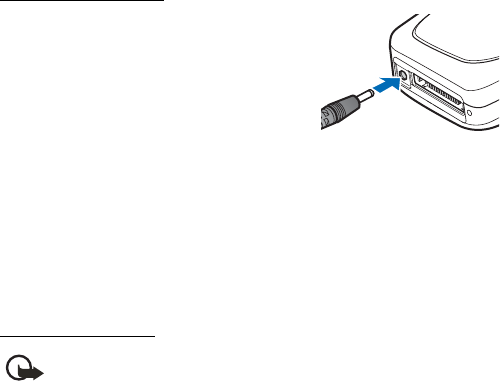
Additional safety information
93
Frequency range (Rx)—AMPS: 869.04–893.97 MHz, PCS:
1931.25–1988.75 MHz, Cellular: 869.70–893.37 MHz
■Battery information
This section provides information about battery charging times with the Travel
Charger (AC-4) and the Standard Travel Charger (AC-3), talk and standby times.
Be aware that the information in this section is subject to change. For more
information, contact your network operator.
Charge the battery
1. Connect the charger to an ac wall outlet.
2. Connect the plug from the charger to the base
of the phone. The battery indicator bar
starts scrolling.
If Not charging is displayed, wait for a while,
disconnect the charger, plug it in again,
and retry. If charging still fails, contact your dealer.
3. When the battery is fully charged, the bar stops scrolling. Disconnect the
charger from the phone and the ac outlet.
The BL-6C battery provides up to 4 hours talk time, and up to 15 days of standby
time. Operation times are estimates and may vary, depending on network
conditions, charging, and device use.
Check the battery
Warning: Use only batteries, chargers, and enhancements approved by
Nokia for use with this particular model. The use of any other types may
invalidate any approval or warranty, and may be dangerous.
Check the model number of any charger before use with this device. This device is
intended for use when supplied with power from an AC-3, AC-4, and DC-4
charger, and from AC-1, ACP-7, ACP-12, and LCH-12 charger when used with the
charger adapter CA-44, which is available at your Nokia dealer or
www.nokiausa.com.
For availability of approved enhancements, please check with your dealer.

Additional safety information
94
The following charging times are approximate with the BL-6C 1070 mAh LiIon
battery:
Travel Charter (AC-4): Up to 1 hour 35 minutes
Standard Travel Charger (AC-3): Up to 3 hours 45 minutes
Talk and standby times
Operation times are estimates only and depend on signal strength, phone use,
network conditions, features used, battery age and condition (including charging
habits), temperatures to which the battery is exposed, and other factors.
Talk time: up to 4 hours (digital)
Standby time: up to 15 days